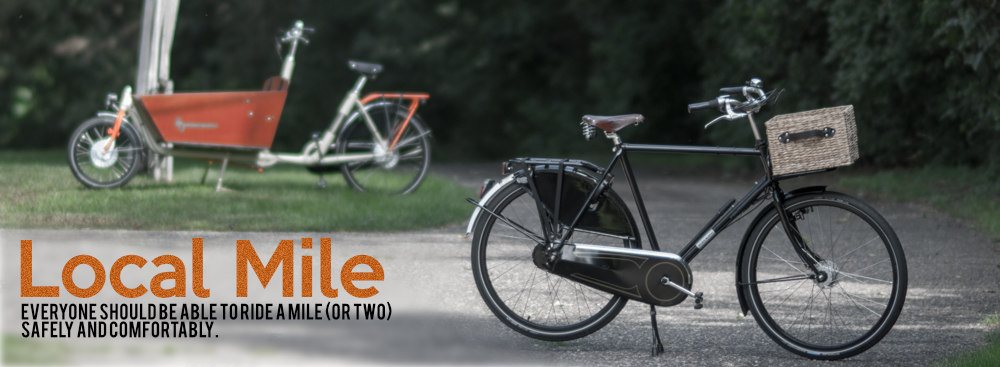Reading Time: There is a lot of information here. This is a book length manuscript. It is not a short article or blog post. Grab some tea, a beer, wine, coffee or scotch and enjoy.
If you’ve not yet done so, please first read or at least skim 1. Intro To Sauna, 2. Thermal Experiences & Glossary, and 3. The Thermal Suite in the top menu. Also, for some discussion on steam read ‘When Löyly strikes again – pilot study findings’ and ‘Why sauna designers should care about the Law of Löyly’.
Note: This is essentially the first part of the original ‘Trumpkin’s Notes On Building A Sauna’. That (now part 5) is now focused on just the notes themselves. Discussions of sauna dynamics, how a sauna works, are in this document. This should eventually make navigation easier and make it easier to find information.
Some Blog Posts: Medium | Trumpkin
—–
Disclaimer: I am not an engineer nor doctor. Nor any kind of expert on sauna. The following is simply a bunch of notes on what we learned building our sauna and that we wish we’d known much sooner. Use at your own risk. Owner/builder is responsible for meeting any applicable building or related codes. I strongly encourage everyone reading this to do further research on all of these topics and in particular to read Lassi Liikkanen’s ‘Secrets of Finnish Sauna Design’ – the book that I really wish existed when we built our sauna. If you find any disagreement between what’s here and what Lassi says then Lassi’s book and website is the safer path. I also highly recommend Lassi as a consultant.
I hate seeing people taken advantage of. I have Asperger’s and that’s one of the interesting traits that comes with it. People in the U.S., due to our lack of knowledge about saunas, are frequently taken advantage of by sauna vendors. That’s not right. Hopefully what follows will help to alleviate some of this.
This is a journey. I am still learning and totally enjoying it. I am, to the best of my ability, trying to communicate what this thing that Finns, Germans and Swedes call sauna is. The goal of this is to be as accurate and informative as possible. If there is anything inaccurate below please let me know so that it can be corrected.
—-
Note (2024.01): My wife has informed me, several times, that the hosting costs for Trumpkin are exceeding my allowance. This is good that so many people are reading (and hopefully benefiting!) from Trumpkin’s Notes and thank you for that. To help defray the costs and preserve peace in our own sauna… As an Amazon Associate I earn from qualifying purchases. This is simply for book purchases. It costs you nothing to use the links on this site but helps to cover the increasing costs for hosting. If there is any income beyond costs then excess will be donated to World Bicycle Relief or Not For Sale. These are both wonderful organizations that I’ve known since before their founding and, unlike too many similar organizations, simply get on with effectively getting the job done. If you are ever in Amsterdam, besides a good sauna (I’d recommend skipping the over popular Deco and instead try Spa Zuiver or Sauna Van Egmond) you should also visit Dignita for brunch. They are run by Not For Sale.
If you find value in these notes, please make a donation to Not For Sale, World Bicycle Relief, or an organization of your choice and please write in the notes “Trumpkin Sauna”.
2024.08.04 – Thank you to all of those who’ve contributed to Not For Sale and World Bicycle Relief! This makes a difference for those organizations and let’s me know that people are finding value in the work that I’ve put in to these notes.
Table Of Contents:
- What Is A Sauna
- How A Sauna Works – The 3 Heat Zones
- Radiant Heat (Sidebar)
- Cold Feet!
- Bench & Ceiling Heights (A Bit Of Physics)
- Misc and End Notes

Sauna bath – Saunaing is a healthy and relaxing hot air bath, alternating between warming up and cooling off. When taking a sauna, the whole body is heated several times in a wooden-surface room with a typical temperature of about 80-105 º C, measured from a height of about 100 cm above the level of the upper sitting bench. Warming is followed by cooling in the open air or with cold water.
Sauna room – The sauna is a wood-paneled room with stepped benches, a heater with stones, a temperature of about 80-105º C measured at a height of about 100 cm above the level of the upper sitting bench, and low humidity, which is briefly increased by infusions of steam created by throwing water on the heater stones.
– International Sauna Association (ISA) – Adopted at the ISA Congress in Aachen, Germany on 5 Aug 1999 (translation by asbasweat.org)
Sauna Is A Finnish Word – Throughout all of Trumpkin’s Notes the concept and definition of what a sauna is and how it is practiced is centered on the Finnish concept and definition of a sauna. Most other cultural appropriations of sweat bathing such as IR cabins or sweat cabins that often usurp the term ‘sauna’ do not fit with this and are therefore not considered a sauna. They are forms of sweat bathing but not forms of sauna.
For another view of this please read Lassi’s Finnish Sauna Basics.
There are three critical elements we need to think about;
- What is the Bather Experience that we want to have in a sauna?
- What Physical Design elements are needed to achieve that experience?
- How do we Practice sauna to get the best experience.
We’ll focus on the first two here. Practice is discussed in Trumpkin’s Intro To Sauna in the top menu.
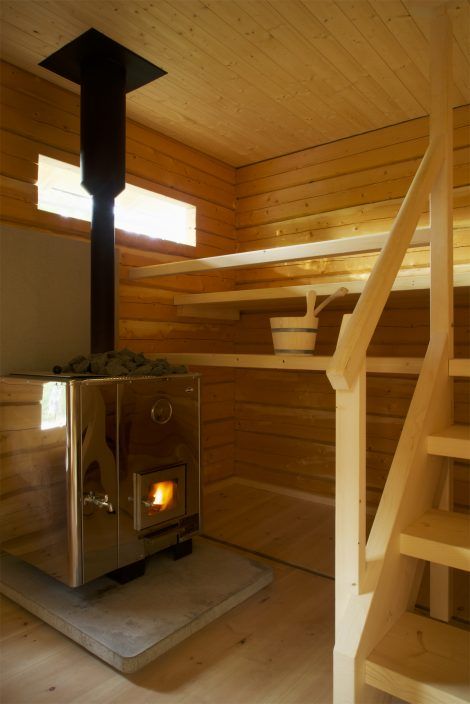 Bathers in this sauna designed by Finnish architects Mattila & Metz are up in the löyly cavity and should have no cold feet. Those closest to the heater might feel some unwanted radiant heat however.
Bathers in this sauna designed by Finnish architects Mattila & Metz are up in the löyly cavity and should have no cold feet. Those closest to the heater might feel some unwanted radiant heat however.
Bather Experience. The essence of sauna is an experience where in the sauna hot room bathers are immersed in hot air: heated very evenly from head to toe, front to back, side to side and minute to minute by convective heat – hot air. Sauna is officially called a ‘hot air bath’ for this reason. When steam is created this steam should similarly envelope us evenly from head to toe and front to back. Here though, in a Finnish sauna, not minute to minute as we want the steam to be temporal. We want to feel the steam, intense or mild, and then have it exhausted very to moderately quickly. The steam becomes uncomfortable if it hangs around too long and we want to be able to do that burst of steam again.
If you want this thing that people in Finland (and Germany, Sweden etc.) call sauna then some critical characteristics include:
- We Are Heated By A Hot Air Bath Of Gentle Convective Heat That Evenly Caresses Our Entire Body; head to toes, front to back and minute to minute. This hot air is created by air flow over the heated stones. Every inch of our body is enveloped evenly by this hot air. We are immersed, or bathed, in hot air. Ideally our feet are no more than 20% colder than our head though as much as 27% may still be considered acceptable.
- We Can Choose Any Temperature from 75-105°c (ideally ± 15°c) for the convective heat we feel on our bodies.
- We Feel No Noticeable Radiant Heat from the heater. Nor any heat that is point-source, harsh, or uneven.
- We Have Continuous Fresh Air To Breath without high levels of CO2, VOC’s, Pathogens, Carcinogens or other undesired odors.
- We Are Not Exposed To Unhealthy Levels of Bacteria, Mold or Other Harmful Elements.
- We Are Caressed Evenly In Good Steam Created From Hot Stones. A burst of gentle steam in a Finnish sauna by throwing water on the stones or a constant drip in a bio sauna. This steam somewhat follows the convective loop, descends down on us from the ceiling and evenly envelopes our entire body head to toes when the latent heat it contains is released in to our body. The burst of steam in a Finnish sauna should be exhausted within about 2-4 minutes (so that we can do it again!).
- There Is A Very Slight Bit Of Comforting Air Movement over our body from a convective loop of hot air rising from the heater and descending down on us from the ceiling. Almost unnoticeable and just enough for evaporative cooling of our skin. Not too much though as that would be uncomfortable.
- We Feel No Cool Drafts, even when someone opens the door.
- We Can Cool Down And Rest. We have good options for cooling down between rounds in the hot room such as jumping in a lake, sea or plunge pool, or sitting outside in cooler air.
- We Are In A Calm Quiet Relaxing Environment without distractions or annoyances.
That is the goal for what we want to achieve if possible. That is what we’re aiming for. It is what going to sauna is all about.
Why is reducing stratification so important? Why do we try so hard to have less stratification for temps and humidity? Why do Finns make such a big deal about ‘feet above the stones’?
- Comfort – Heat – For most people a temp difference of feet no more than about 13-15% colder than their head is most comfortable and enjoyable but as much as 20% colder is OK. At about 20% difference people begin to experience ‘cold feet’ and by about 27% difference just about everyone has cold feet. This is most evident in Europe where as the head to toes difference increases so does the number of people pulling their feet up on to the sitting bench. At 20% a few will, by about 24% half will and by 28% usually everyone will.
- Comfort – Steam – Steam is buoyant and likes to remain high up and it does not like to move in to cooler air. So we need to be higher up for steam and we need the air temp around our body as even as possible as otherwise the steam will not descend down in to the cooler air around our legs and feet.
- Enjoyment – A cold plunge, roll in the snow or simply standing outside is most enjoyable after having our body fully immersed in very even convective heat. This so that every inch of our body has been heated and our core temp has risen. The difference between a proper sauna and a pseudo-sauna that doesn’t meet these criteria is surprisingly huge, particularly for cold plunge.
- Hygiene – The foot bench needs to maintain about 60-65°c to kill bacteria and other germs and nearly that to kill mold.
- Health / Fitness / Medical – For most health and medical benefits we need our entire body fairly evenly enveloped in convective heat. 22% head to toes difference seems the maximum. If our head is 100°c (212°f) but our lower body is a lot less, more than about 22% colder, then our lower body is likely not getting the localized musculoskeletal benefits nor are we raising our core temp enough for benefits that require an increase in core temp. Here is how stratification may degrade the effectiveness of raising our core temp:
- Good Sauna (18% head to toe ∆): 84% effective
- Acceptable Sauna (22% head to toe ∆): 81% effective
- Barrel (50% head to toe ∆): 56% effective
- Homeostasis – Our body wants to be in homeostasis and always tries to achieve this. A significant head to toe temp difference goes against this and not in a way that we want.
- Dry Cracked Feet – Having our feet up in the steam can lessen problems of dry cracked feet, particularly during winter.
People (just about everyone in North America) who’ve never experienced a proper sauna with even convective heat don’t know what they’re missing and are in for a treat when they do get to experience it!
Why do we want the airflow of a convective loop? Three key reasons;
- Reduces stratification – See above.
- Critical to remove CO2 and other contaminants – Without this loop of airflow the CO2, pathogens and other bits just kind of hang in the air, don’t get exhausted and we inhale them.
- Cools our skin – Evaporative cooling of our skin is important to our comfort, and for those seeking health benefits to being able to stay in long enough to effect those benefits.
We want air flowing over our skin to cool it? 🙂 Yeah, that sounds confusing, aren’t we trying to do the opposite? Yes, but also no. Stagnant air, even if convective heat and not radiant heat, feels harsh and sometimes almost burning – our skin surface gets much hotter than the rest of our body deeper within. A bit of airflow over our skin helps to cool our skin via evaporative cooling of moisture and sweat. This is not only a lot more comfortable but also allows time for the heat to penetrate deeper in to our body. We generally don’t want too much airflow though as that is uncomfortable as well but rather a gentle and perhaps almost unnoticeable flow of air over our entire body.
The benefits are similar to reducing stratification; more comfortable and enjoyable with better health benefits. And here again, the difference in a cold plunge is quite amazing. A cold plunge after a proper sauna is a totally different and better experience than a cold plunge after being in something with radiant or a lot of stratification, neither of which have resulted in properly heating our body.
Bad air, particularly from high CO2, not only directly effects our muscle recovery but also how long we stay in. In a proper sauna not only do we benefit from more effective heat (84% vs 56%) on our body but we stay in and benefit from that heat longer which results in raising or core temp that much more. From a core temp perspective we likely achieve twice the benefit from a good sauna as from a bad or worse sauna.
This evaporative cooling is also why we want to be nude or have as little of our skin covered as possible as any skin covered by cloth will not benefit from this evaporative cooling.
One sort of exception to a stronger air flow is that a quick burst of very noticeable air movement from our swinging a towel around quickly or that produced by an aufguss master can be quite pleasant (or punishing 🙂 ). Interestingly this seems very specific to that produced with a towel or other cloth. Similar air movement produced by a circulation fan, even if done in bursts, is not the same nor is it pleasant. Even more interestingly I think the difference is that a towel produces a very uneven wavy airflow so here is one case where uneven is actually good.
How do we achieve that bather experience? What is critical in the Design? Traditionally the best and perhaps only way to meet these goals has been a somewhat large, well ventilated, wood lined room, heated by a mass of stones, with bathers seated well above the cold zone and above the top of the stones in what people in Finland call the Löyly Cavity. This gives us the 7 laws of löyly.
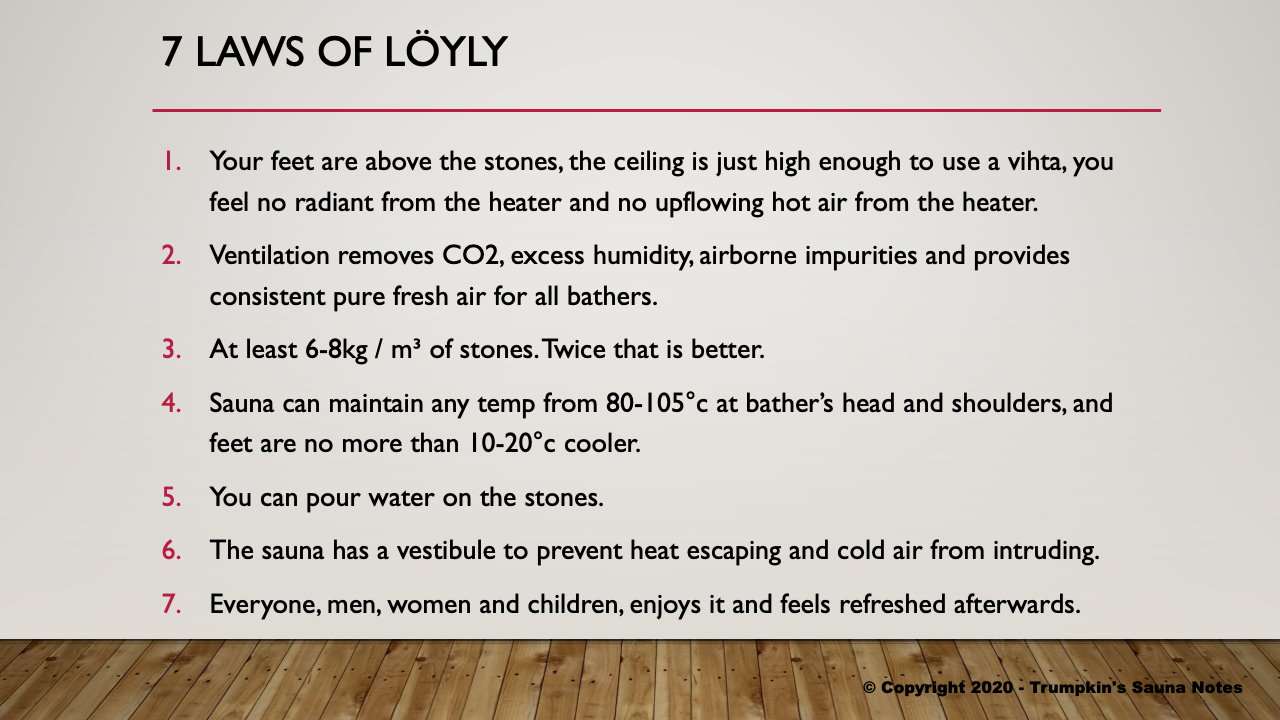
That is still the best way to meet our sauna goals and results in the most enjoyable experience.
It’s important to keep in mind that the higher benches and ceiling are NOT about higher temps but rather about more even temps and steam – head to toes.
The high ceiling (typically 255cm or 100”) required for this is not always possible though so newer options, including open-sided heaters and air circulators such as a Saunum, have been introduced to provide us as good an experience as possible when proper higher ceilings and benches are not possible. Efforts are continuing to improve this with one of the more promising what I call a ‘Convection Engine’ developed by Sauna Sitter.
Other critical or desirable elements include;
- We are in a quiet, calm and relaxing environment.
- We can easily and comfortably cool off with a shower, bucket of water, in a lake, cold plunge or standing outside.
- We have a comfortably cool place for relaxing between rounds. Outside if appropriate weather or a cooler area (< 18°c / 64°f ?) inside.
- We are able to slowly enter back to the heat. Going from cool to abrupt hot can be uncomfortable and make the entire sauna round less enjoyable. It’s desirable to go from cool to a warmer changing room for a minute or two, to the lower cooler part of the hot room for a few seconds and then climb up in to the heat.
These notes are focused on achieving these goals – experiencing sauna in the same way as it’s enjoyed in Finland and Germany – By creating a löyly cavity in the sauna and placing bathers in the löyly cavity.
—–
The Spirit Of Sauna
If you visit saunas in Finland, Germany, Austria and many other countries you’ll notice a spirit around sauna. It’s a spirit of very genuine regard for others and this is as or more important than anything else about sauna. We talk about the heater being the heart of a sauna and the convective loop that creates the löyly cavity and carries the steam it’s soul, but this spirit is the foundation that those come from. And this exists with other thermal experiences from Banyas to Onsens to Spas.
This is the core of etiquette. This is thinking about others and doing what we can to make everyone else’s experience the best possible. This is not carrying unnecessary bacteria in to the sauna or cold plunge. This is being calm and quiet so that we don’t disturb others. This is I think, as important as anything else in this document.
Löyly and Sisu
Löyly, pronounced kind of like Low-Lou, is critical to sauna. Löyly is a Finnish word that traditionally meant Spirit or Life but today is used as a descriptor for a good environment in the sauna. It has no english equivalent. A wood lined room with benches, heat and steam but without löyly is, according to Finns, not a sauna.
“Steam added to bad stale air is just that, steam added to bad stale air, it is not löyly”
Löyly is not just the steam created from throwing or ladling water on the stones. That’s just steam. As we do, Finn’s have a word for that also, höyryä.
Löyly is, according to a 1988 Finnish research paper, “the purity, freshness, temperature and humidity of the air in the sauna”.
Löyly is about quality, not quantity. Löyly is what a bather experiences when they are heated evenly head to toe, front to back and minute to minute by a convective loop that creates a löyly cavity. The temperature at their head and shoulders is about 75 -115°c. The air is pure and fresh without high levels of CO2, colognes, mold, bacteria or other contaminants or scents. Undesirable direct radiant heat is unnoticeable. Ample soft wood walls and ceilings help to maintain a comfortable environment and absorb some noise so that the sauna is quiet and peaceful.
Water is thrown or carefully ladled on the mass of stones producing a burst of invisible steam that is carried with the convective loop up, across the ceiling and down to envelope bathers bodies for a brief period of one or two minutes and is then quickly exhausted returning the sauna to its original drier state – so that the burst can be comfortably repeated.
That, all of the above combined, is Löyly.
“Löyly is about the QUALITY of the heat more than the QUANTITY.”
Our goal isn’t getting to some temp, but to have good quality heat. When you experience quality heat and löyly and get use to it, you never want to go backwards.
—-
But there’s a bit more nuance to it. If a Finn visits my cabin and we go to my new sauna building down by the lake but the foot bench is below the top of the stones and so below the löyly cavity, they will have uneven temps around their body and cold feet – they’ll not experience löyly. And question if this is even a sauna.
However, if we visit the sauna in my small 3rd floor city flat and it has similar too low of benches then my Finnish friend will proclaim it good löyly. Even though they might have had colder feet than the place at my cabin! What gives?
The difference is that in my flat they knew that I had space constraints with no option to build it higher or larger so I did the very best I could. I showed perhaps, a tiny bit of Sisu. I was tenacious in achieving the best quality sauna experience I could given hard unavoidable constraints – I was determined and persevered. At my cabin I could have built a proper sauna with proper bench heights. There the sky is, quite literally, the limit. But I didn’t. I took a shortcut. I made a löylyless pseudo-sauna when I could have made a proper sauna. Just the opposite of Sisu.
Sisu goes beyond individual saunas to saunas in general. Sauna builders in Finland constantly strive to learn and to understand how saunas work to make their saunas better so that the experiences of their customers will be the best possible. They want the saunas they’ll build next year to be better than the saunas they’re building this year.
A great example of this is that after decades (or centuries) of fresh air supply entering near or in the floor of wood heated saunas, they are now doing a fresh supply vent above the heater so that these saunas can have as good of air and löyly as electric heated have.
There is a lot of room for aesthetic variation though, so long as the fundamentals are not compromised too much. A large window is not ideal but when there is a really great view it’s understandable. Benches below the löyly cavity or poor ventilation are not so understandable.
How do we know if we’ve got löyly? There are two ways to get an idea of what a good sauna is; 1) Experience and Observation and 2) Physics and Measurements.
One huge advantage that people in Finland have is a country full of good saunas to experience and a bunch of builders who know sauna. We don’t have either. Some things to try though might be:
- If you blow on your feet and can feel any heat then you might have cold feet and could benefit from higher benches.
- If you ever feel light-headed, dizzy, tired or fatigued, confused, have a tingling or pins or needles feeling, or feel like you need to leave the sauna for some fresh air then you likely need better ventilation. In a sauna with proper ventilation and good löyly your breathing should be very relaxed and normal, you should always be able to comfortably, easily and steadily breath through your nose and never feel like you’re suffocating in any way.
- If you close your eyes you should not be able to tell where the heater is, you should not feel any heat directly from it, and you should feel even heat around your entire body head to toe, front to back and minute to minute. Your head should not be noticeably warmer than your feet and your back not cooler than your front.
- With your eyes still closed, have someone throw a few ladles of water on the stones. You should feel a wave of heat descend on you from the ceiling (it should not come at you as a frontal wave) and then feel it work it’s way down your entire body from your head to your feet, caressing you evenly on all sides in its warmth. It should perhaps be just short of unbearably hot but quite wonderful for this brief period and then just when you think you’ve had enough of it, it disappears and is exhausted.
A second element is Objective Measurements and while not very romantic, they are the best way to take some of the guess work out of knowing what a good sauna is and so how to build good saunas. Measurements allow us to know objectively how a sauna performs and if it at least has the capability for quality heat and löyly. Some targets to aim for include:
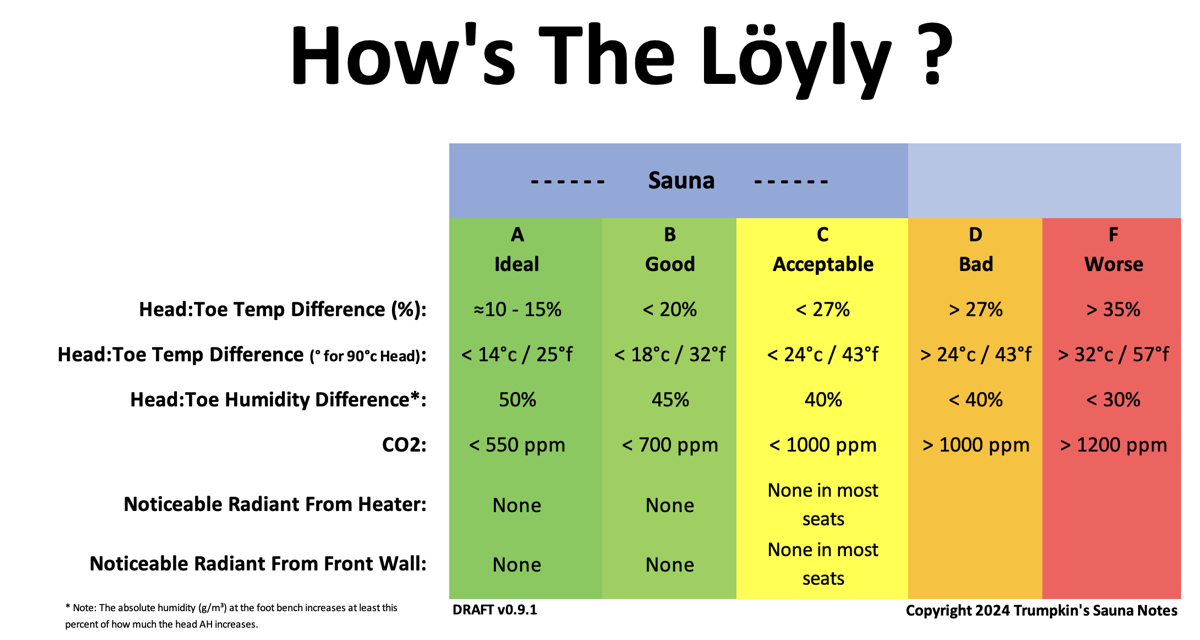
A good sauna builder will aim for and meet at least the criteria for an Acceptable sauna and often for a Good or even Ideal sauna.
There are some elements that can’t be so easily measured though such as heat being even front to back, how soft the steam is, etc. For these we have to rely on our senses.
Jesse Hämäläinen of Narvi Sauna Heaters says “There is no shortcut to löyly, it is always about stones and proper ventilation”.
It’s A Sauna For Today!
Folks in Finland can be quite picky about their saunas. And that’s what these notes are based on. But above all they like to sauna. So if they’re at a beach and the only sauna available is a not-so-much-a-real-sauna-barrel-on-a-trailer – they’ll consider it good enough for today and enjoy camaraderie with others. And while it might be an acceptable sauna for a day, it’d not be anything they’d want in their yard to use regularly.
Similarly they might carry a tent and stove to make an impromptu sauna on a hiking trip or build a bunker sauna on the battlefield. And while these wouldn’t be the quality of sauna experience they’d want every day, it’s the best they can do given the circumstances and so good enough.
Lost In Translation: Why Are American Saunas So Bad
“90% of saunas in North America are bad. The other 10% are worse.”
– Mikkel Aaland
– Board Members, Finnish Sauna Society
– Finns of all sorts
Why do they say this? And why is what is written here in this document so different from most of the rest of what’s written about saunas in english?
If you talk to sauna builders and experts in Finland you’ll consistently hear three things; ‘feet above the stones’, ‘ventilation’ and ‘bigger is better’. Most of what is written in english has however said the opposite; Saunas should be no more than 7’, should be small, and well sealed or have only a gap under the door for ventilation. And just about every sauna in North America has been built like that so it’d certainly be easy to assume that 7’ is correct.
Why the difference? Just a few decades ago:
Finns said “Feet above the stones, which can usually be accomplished with 1900-2300mm (6’2” – 7’6”) high ceilings.
Americans said “Cool, 7′ it is.” (We do like to simplify things!)
That was with much smaller heaters though. Just as we went through a period of poor quality building (homes, cars, etc.) in North America through the 60’s – 80’s, Finland went through a period of poor quality saunas. This I think primarily with heaters that tried to economize with lessor stone mass. As Finns re-realized how critical stone mass really was for producing good convective heat and steam, the heaters got bigger – and they raised their benches accordingly. But we in North America were stuck on 7’. And we totally ignored “jalat kivien yläpuolella” – “Feet above the stones”.
We also missed when people in Finland realized that even with feet above the stones a low ceiling sauna does not work well and traditional higher ceilings and benches are needed.
Similar with ventilation. Finns changed how they do ventilation in the 1990’s but that was all written in Finnish. It never made the leap to english so we’ve been doing either 1970’s ventilation or in many cases the even more misguided idea of no ventilation.
The crux of the problem then is, I think, one of simple translation. We’ve not been getting the same info about saunas as Finns and others.
A second problem on top of this is UL standards that were written by someone who didn’t understand sauna nor any of the physics involved.
Sauna Temperature
Temperature is important but temperature alone is quite unimportant.
Finns don’t ask what the temp was, they ask how the löyly was.
As or even more important is the quality of the heat and quality of the environment – löyly. It’s important that the temps on bathers bodies are fairly even all over, head to toe and front to back and minute to minute, that the air is fresh without high levels of exhaled CO2 or built up humidity, bathers experience the convective loop and steam of the löyly cavity descending down on them from the ceiling to their toes, and there is no undesirable radiant heat. These are the ingredients of löyly. It doesn’t matter if the temperature in a sauna ‘got to 200°f’ if your feet are only 140°f, you’re being unevenly roasted on one side by radiant heat from the heater or you’re feeling light headed because of bad air.
That said… The official recommended temperature is 80-105°c (± 10°c) (167-221°f (± 20°f)) – measured at a point 1m (39”) above the middle of the longest sitting bench opposite the heater. A good sauna should be able to maintain any temperature in that range. I think if all the other parameters are good (fresh air, no radiant from the heater, even head to toes temps/steam) that as low as 60°c could still be considered a sauna.
A Brief History Of Our Understanding Of Sauna (and Sauna Physics)
How did we get where we are today? Over time we (humans, mostly Finns) have come to understand the physics of how saunas work better each year which has resulted in increasingly better saunas. If you follow Lassi’s Saunologia website (highly recommended) you’ll see that we are still learning.
1961: Feet Above The Stones – Sakari Pälsi stated this in his 1961 book ’Sauna’. Known today as ‘Pälsi’s Law’ or ‘The First Law of Löyly’ it is one of the most fundamental elements of good sauna design. It was known prior to this (lithographs and photos of saunas prior to this almost all have high benches or a high platform) but Pälsi is the first that I’m aware of to state it succinctly.
1960’s: Overall volume of at least 3m³ (105 cubic feet) per bather. While most saunas usually met this requirement it was documented officially to combat the health problems being seen from an increase in much smaller saunas beginning to be built in city flats. We see this also in English in Johnson & Miller’s 1977 ‘The Sauna Book’ and Alan Konya’s 1987 book ‘Finnish Sauna’.
1980’s: Stone Mass For Electric Heaters – Until this point most electric sauna heaters had very little stone mass and for some the stones were little more than aesthetic. This is one reason why electric heaters got such a bad name. During the 1980’s there was a growing realization of the importance of stone mass in electric heaters for better quality convective heat and steam. This resulted in increasingly larger heaters (and so also commensurately higher ceilings and benches to keep ‘feet above the stones’). Calls for even greater stone mass continue.
1992: Mechanical Downdraft Ventilation For Electric Saunas – Electric heated saunas were largely using the same ventilation strategy as wood heated – typically a gap under the door and an exhaust vent high on an opposite wall. This didn’t work and was another reason electric heaters got a bad rap. During the 1970’s and 80’s builders across Finland began experimenting with other options with Mechanical Downdraft seeming the best. VTT did some studies on this in 1992 and found that it was indeed the best and really the only good option. Soon after the official RT system was updated to reflect this.
Late 1990’s: Open Sided Mesh Heaters – Along with the realization of the importance of stone mass came the first open sided mesh heaters from Iki. These were initially marketed as eliminating the need for higher ceilings and ‘feet above the stones’. Some still believe (and market) this even today but better builders quickly learned that this wasn’t fully the case and that benches and ceilings still needed to be high up. These heaters still provide benefits in stone mass and aesthetic appeal.
2020’s: Combustion Downdraft Ventilation For Wood Heated Saunas – Noting that the air in newer electrically heated saunas with mechanical downdraft ventilation was fresher and less stale than that in wood heated saunas, sauna builders began incorporating a fresh air supply above the heater in wood heated saunas.
—-
I should add here another very brief bit of history – of bathing in general. From the early 19th century until somewhat recently, doctors and others calling for various thermal treatments, particularly cold water therapy but also varying forms of dry and wet heat such as saunas and roman baths, have been called quacks. This reached it’s height perhaps in the 1920’s-1960’s. And today as we learn more and more about human physiology we are also learning of the benefits of many of these thermal treatments that a hundred years ago were considered quackery.
How a sauna works, from physics and physiology standpoints is, …very very cool 🙂
There are three critical zones in a sauna that we need to know about; The Löyly Pocket, The Cold Zone, and The Heat Cavity.
The stones and heater are the heart of a sauna and the convective loop that creates the löyly pocket and the steam it carries are its soul. Let’s look quickly at how these work, what makes a sauna so special and different from other forms of sweat inducement, and how these affect our design.
There are two powerful forces at work in a sauna; Convective loops that work for us and thermal stratification (due to buoyancy of hot air and steam – the stack effect) that works against us. And it all begins in the heart – heat from the heater.
Convective Loop – The heat produced by the heater heats the stones. The stones, thanks to a lot of mass, surface area and air flowing up through them, convert this heat to hot air (convective heat) that rises up from the heater.
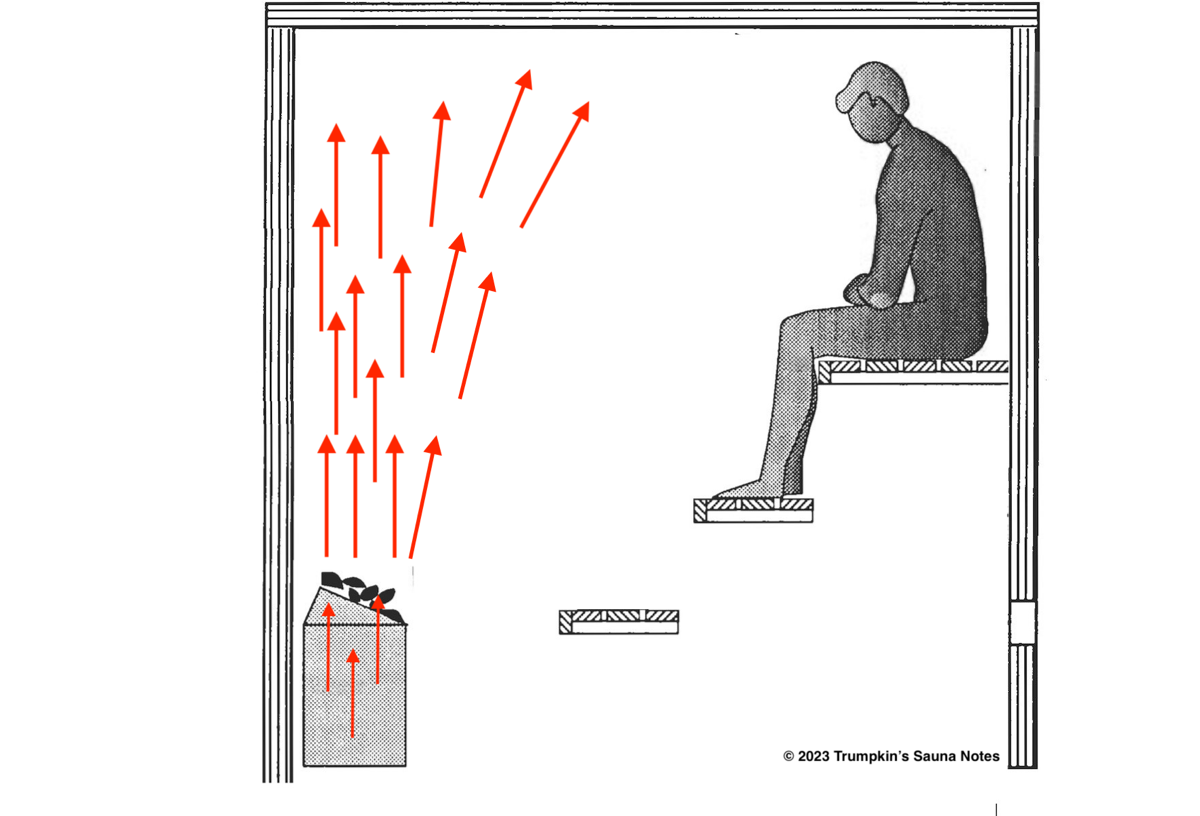
As it rises above the heater it creates a bit of a vacuum and so starts pulling in additional air from the same strata (height) – the three lighter colored arrows below. It doesn’t pull much or any from lower as that would require too much energy. This then creates a low pressure area or vacuum where it’s pulling this air from.
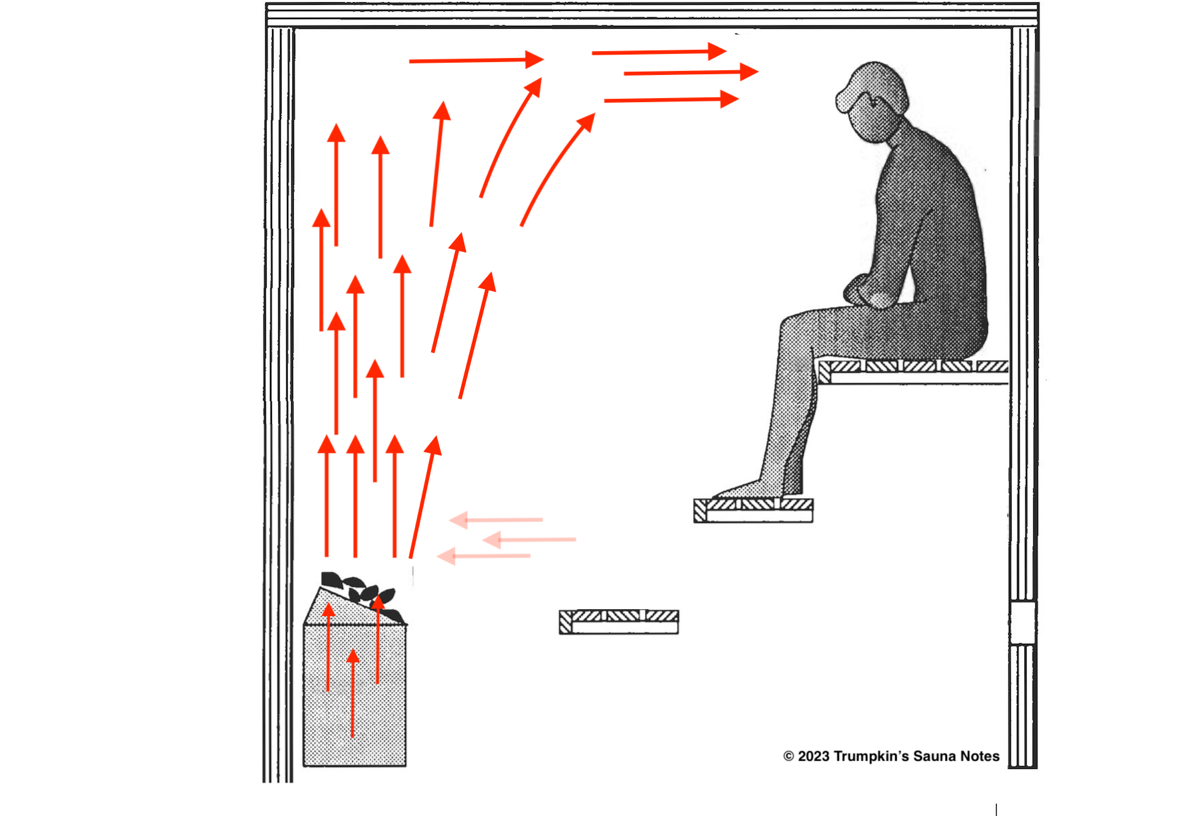
The rising hot air continues across the ceiling, pushed away from the rising plume from the heater, towards the far bench wall and then as this air cools it flows down the bench wall where it heats us. At the same time the vacuum pulls this downward flowing air back towards the area just above the heater where it is reheated and continues around again – our convective loop!
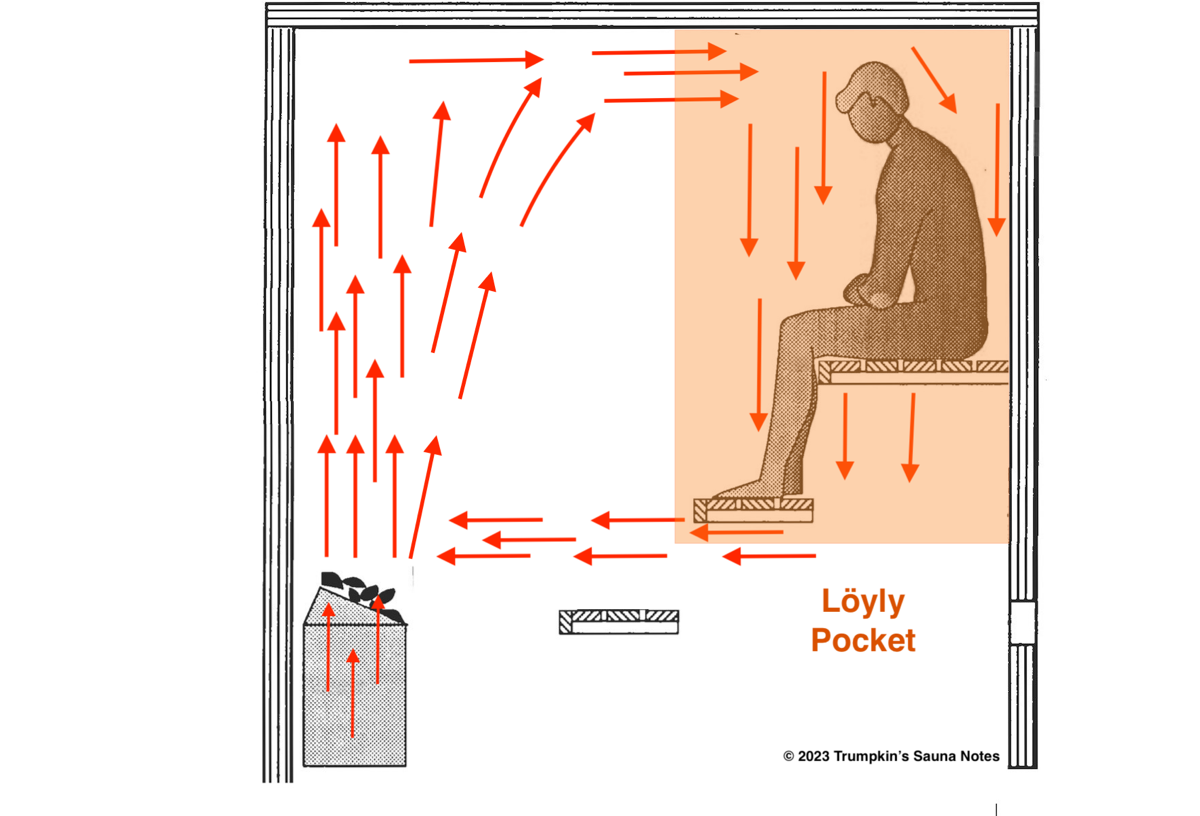
The area where this convective loop is, where it is downward flowing and where steam fills it (the orange area in the image above and green in the image below), is called The Löyly Pocket – it’s where löyly is. This is why Finns so often repeat ‘Feet Above The Stones’ and why that is called the First Law of Löyly, because being up in this convective loop is key to our experiencing löyly. If our feet are lower and below the convective loop then they’ll be out of the löyly pocket and colder which isn’t so comfortable.
This air began its journey at perhaps 160°c or hotter and cooled and evened out as it progressed along so it’s cooling to perhaps 95°c which is what we want.
In addition to being above the top of the stones, we want to be in the downflow portion of the convective loop where the heat is more even and less intense. About halfway between the heater and any wall surface is the Convection Divider or Convection Separator. This divides the rising air from the descending air. We want to avoid being on the rising side as that’s much more uneven temps and steam. We want to be only in descending air.
If our sauna is too small then part of us could be on the wrong side of the Convection Divider, the convective loop can be discombobulated, and in some cases we’ll feel hot air rising up directly towards us which is quite uncomfortable.
Steam – When we throw water on the stones, thanks to all of the hot surface area of the stones we get steam, which initially flows with the convective loop up, across the ceiling, descends down on us and (thanks to the latent heat of vaporization) temporarily causes a significant and quite wonderful increase in the amount of heat that we feel. Note that the air temperature does not change though.
Steam also expands and so some of it will begin filling any low pressure void it can find which results in some of it flowing directly towards us.
This image below shows the journey of the steam from when it first begins to a bit later when it’s reached us and we are experiencing it.
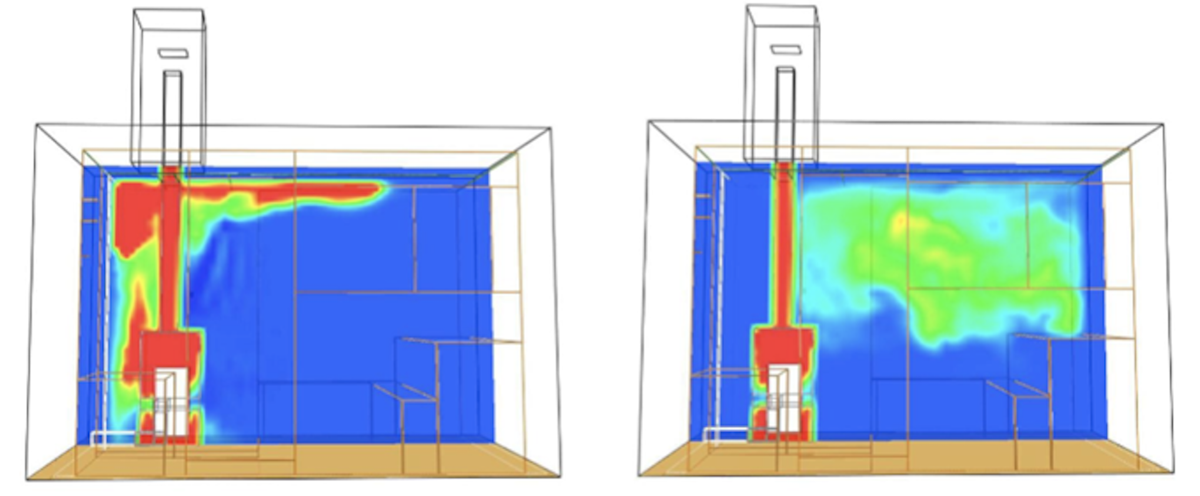 Image: Corentin Maqueron
Image: Corentin Maqueron
Below is a detailed chart of what’s happening with steam. The foot bench in this sauna is at 85cm (33”). It’s just above the cold zone but about 10cm (4”) below the top of the stones of the open sided tower heater. Without ventilation the foot bench is about 25% colder than head temp which isn’t good. With Mechanical Downdraft on (which was the case in the chart below) it’s closer to about 18% which is good.

HOWEVER, as we can see with the two lower probes (calf & foot), steam doesn’t want to go down so low and thus we still have cold feet. Raising the benches should fix this problem and result in a much more enjoyable and comfortable sauna.
Note also the progression of the steam. It envelopes our head first and then about 4 seconds later (when blue line rises up) has reached down to mid back. It gets to our lower back about 19s later and then after another 14s has extended down to the sitting bench. It never reaches down much lower though, there’s a little bit there but not much.
Now that we have a way to accurately measure humidity (thanks Ted!) this winter (2024 – 2025) several of us are doing some tests and simulations to try to determine what role what elements play – what affects how well steam evenly envelopes us head to toes and front to back. Some of these elements are;
- Height above stones
- Benches and permeability
- Height above cold zone or overall height within the space
- Convection Loop/Force (e.g., what effect does a convection tube play?)
If we have proper ventilation then this steam can be removed fairly quickly. Above we’re almost back to normal dryer convective heat after about 2.5 minutes, which is good because with full steam we can’t really stand it much longer than that – it’s wonderful for 2 minutes, not so wonderful for 5. It will be about another 15 before it’s all fully removed. We can adjust the ventilation to allow the steam to linger a bit longer if desired for a more ‘continental’ sauna experience that’s more popular in Germany, Austria and elsewhere.
“The heater and stones are the heart of a sauna and the convective loop, the steam it carries and the löyly cavity are its soul”
This is the core of what a sauna is and is what makes sauna so special. This convective loop, and in particular the portion that carries steam, is critical to good sauna and to löyly so the area of this loop and steam is called the Löyly Cavity or Löyly Pocket. In designing a sauna we want to be careful to facilitate this loop, take advantage of it, and not interrupt it.
One fun bit is that this air or steam at the ceiling will flow in the direction of lowest resistance – which is usually towards the furthest corner from the heater. It’s not unusual in a sauna in Finland to see people doing a wave. The steam gets to the furthest person first and so they lean forward elbows on knees, then the person next to them and so on.
But wait, there’s more behind the scenes of this convective loop…
Thermal Stratification – In any space, hotter buoyant air rises and cooler denser air sinks. This is thermal stratification and is what is behind the ’stack effect’ in building science. In a typical sauna the air at the floor might be about 40°c (104°f) ±. So if we’ve heated our sauna to 94°c (200°f) at the ceiling then we’ll have a 54°c (96°f) difference between the floor and ceiling with graduated temperatures between. In a 250cm (98”) high sauna for example we gain about 0.2°c / cm (1°f / inch) above the floor – on average.
Our body is happiest when it’s about the same temp head to toe. Sitting on a bench in a sauna however there’s about 150cm (58”) difference in height from our toes to our head and so, thanks to thermal stratification, potential for about 32°c (58°f) or more of temperature difference. Our body doesn’t like this, it results in ‘cold feet’ and isn’t wonderously comfortable.
In this chart of a typical 7’ high American sauna the teal line is the temperature 4″ above the floor, orange is 20″ high (so 2″ above an American foot bench), grey is 40″ (so about the height of a Finnish foot bench), yellow is 60″ and blue is 80”, just below the 84” ceiling. The foot bench here is perhaps 100°f (37°c), about 85°f cooler than bathers heads. 100°f feet would normally be considered hot but here, relative to our head, it’s very cool and so ‘cold feet’.
This foot bench is also well below the 62°c necessary to kill bacteria and mold.
The less head to toe temp difference the more comfortable and enjoyable the sauna. Finns and others aim for the foot bench to be no more than ≈15-20% cooler than the head temperature. Or for a 100°c head temp then no more than about 15-20°c (27-36°f) difference. Also notice that the temp at the floor (teal line) hardly changes. And at 20″ above the floor there is change but very little.
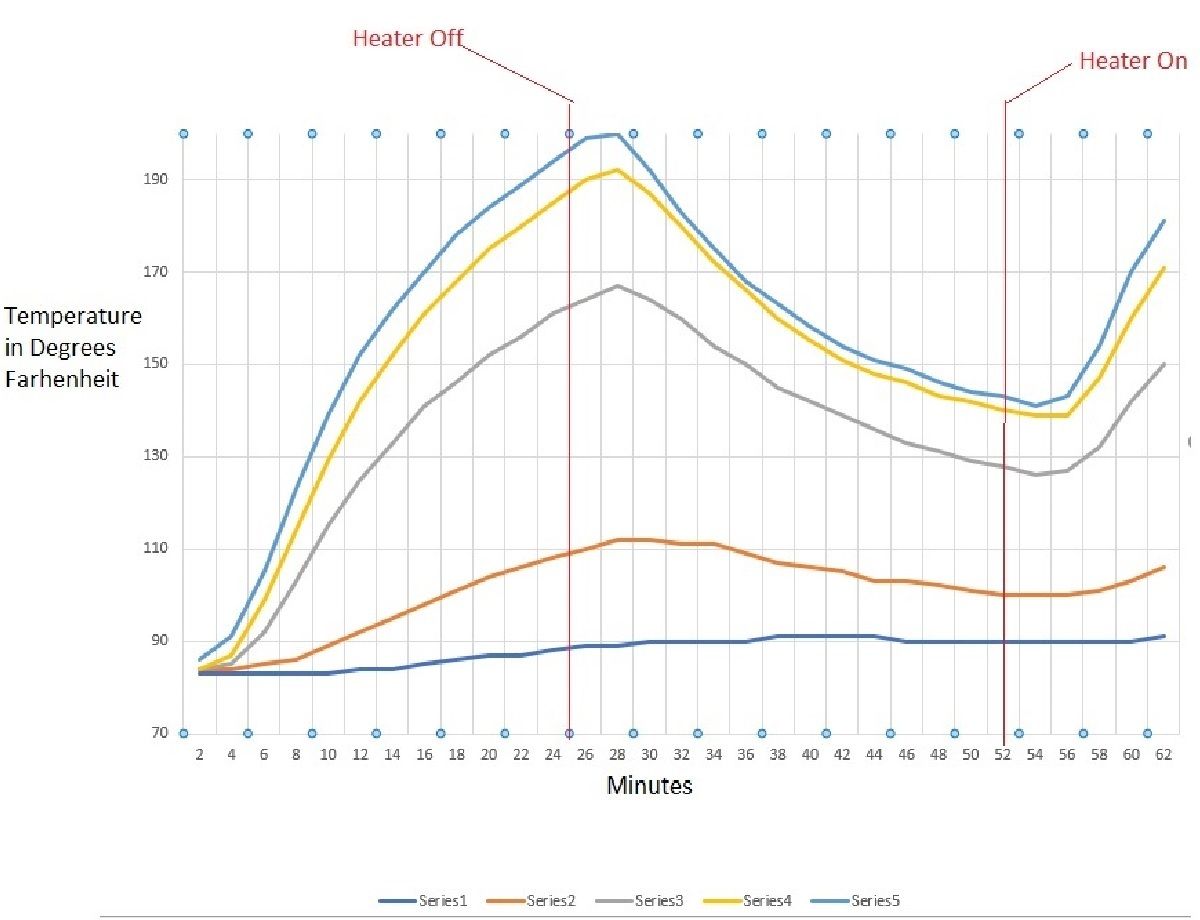
There are three key things that can help us overcome stratification and achieve the more even temps we desire; a higher ceiling & benches, a good convective loop, and Downdraft Ventilation via the convective loop.
The greater the distance between the floor and ceiling, the higher the ceiling, the less temperature difference there is per inch so the less difference from head to toe. This is good. Note also that a lower ceiling DOES NOT result in a warmer floor (teal line above). The floor will be about the same temp no matter how hot the ceiling is and no matter how powerful the heater.
A higher ceiling also allows our benches to be up higher above the colder air nearer the floor. That’s good also.
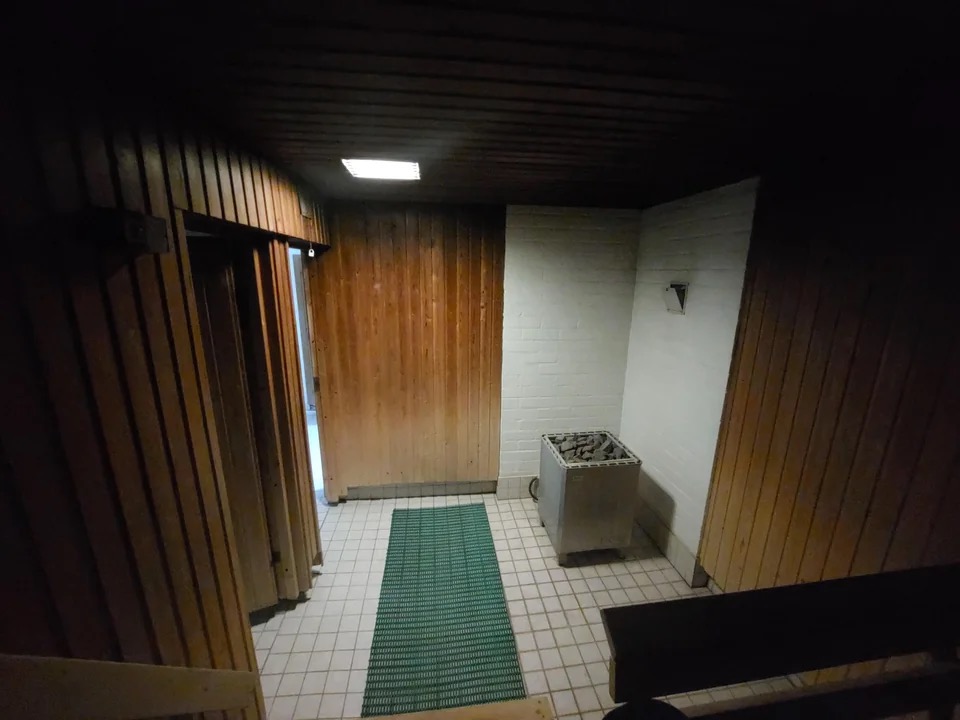
In this photo (above) of an older sauna that has not had a refresh in some years you can quite literally see where the löyly cavity is by the darker wood and where the cold zone is by the lighter wood. The löyly cavity in this sauna is 6-10” above the top of the stones. We want all of our body to be up in that löyly cavity. Also note the fresh air vent above the heater – a very early implementation of mechanical downdraft ventilation. Thanks to Valikasi for the photo and pointing out ‘the löyly line’.
Where there’s a downward flow of air, such as with the far side of the convective loop on the bench wall, there’s less stratification because warmer air is being pulled downward. So not only is the convective loop warming us, it’s also reducing thermal stratification in that part of the sauna to make it more comfortable and enjoyable. So we want to be in this half of the room, where airflow is descending and not in the half where the heater is and airflow is rising.
Where there’s a plus, there’s often a minus. The top and bottom extremes, 30°c at the floor and 90°c at the ceiling, haven’t changed so if there is less stratification up where the convective loop is then there must be greater stratification down below where the convective loop is not. And not only is there greater stratification but there is also colder air that sinks to this area. About one-third of the air in a sauna is more than 20% colder than the warmest one-fifth of the air.
This lower third is called the Cold Zone – it’s about the lower third of the volume of the sauna. It’s the area where the air temperature is more than about 20% colder than the temp at the ceiling. We want to avoid any part of our body being in this lower third Cold Zone.
A note on extra large, typically commercial, saunas – if our head is not in the upper fifth then the calculus gets a bit more complicated. If the ceiling peak is 350cm for instance, our head may be far enough below the upper fifth hottest air that our feet can be in the cold zone and yet still be comfortably within 20% of our head temp.
And finally, ventilation that flows upwards from a low supply to a high exhaust will carry colder air (and contaminants) from the cold zone up to us in the löyly cavity. That’s not good. Downdraft ventilation with air entering the convective loop above the heater, flowing with the convective loop to provide fresh air for us and then exhausting stale CO2 laden air from below the foot bench or the bottom of a wood fired heater enhances the convective loop rather than work against it. This is good.
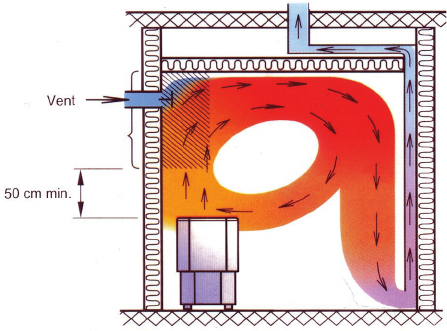
In this chart (below) of our sauna you can see where I turned the mechanical downdraft ventilation on @ 17:16. This reduced stratification by pulling warmer air downward resulting in an increase in foot temp of ≈8°c and that brought the head to toes temp difference from about 27°c to below 20°c. This makes a noticeable and welcomed improvement in comfort and enjoyment. We average about 17° head to toes temp difference for our sauna which I’m happy with.
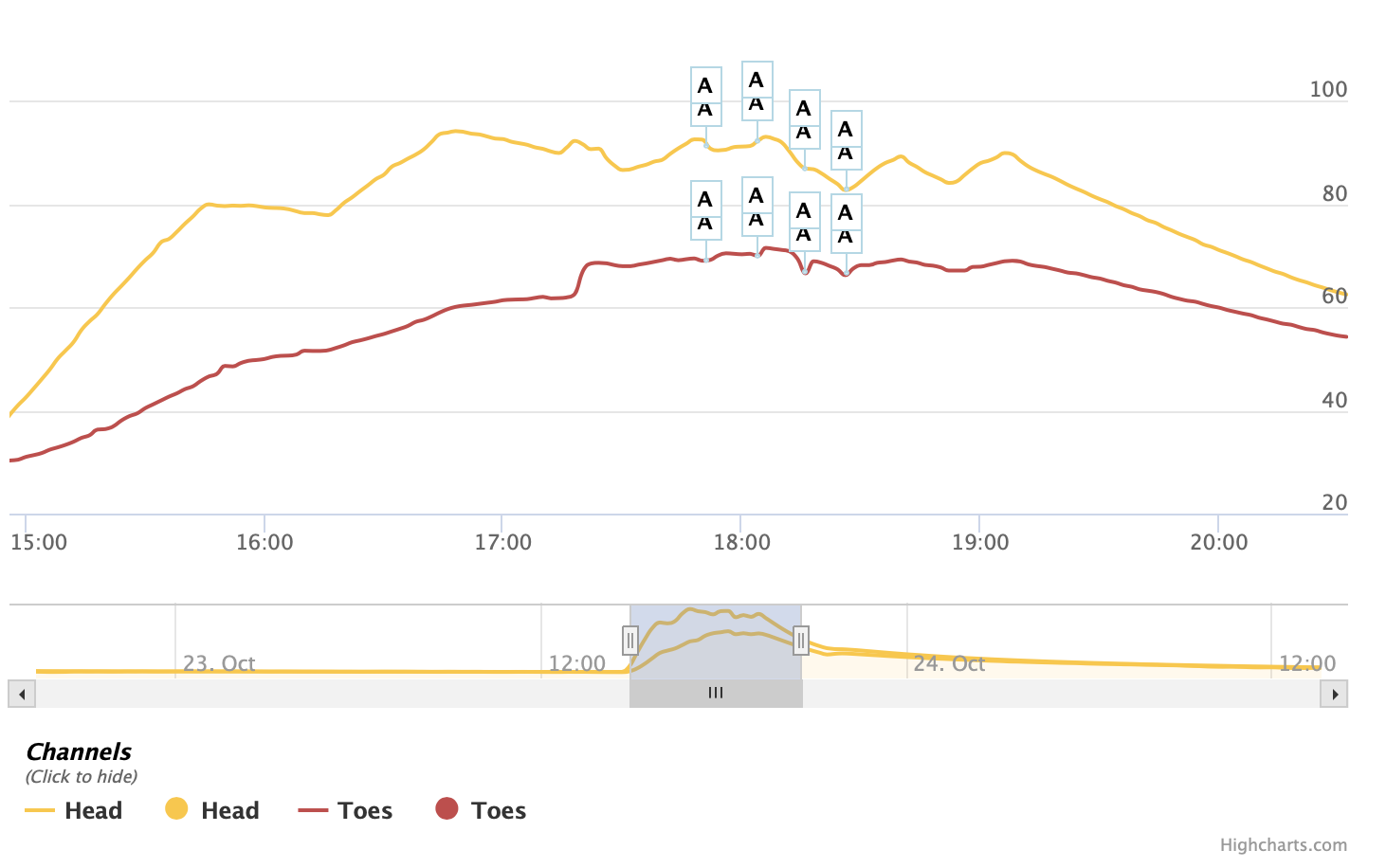 Mechanical Downdraft Ventilation was turned on @ 17:16 which results in a very welcomed improvement by decreasing head to toes temp difference (and removing CO2 and other contaminants). I had the sauna @ 94°c for the first round and then decreased the temp to 85°c for the next three rounds that my wife joined me for. The audit points indicate in and out for the first two rounds.
Mechanical Downdraft Ventilation was turned on @ 17:16 which results in a very welcomed improvement by decreasing head to toes temp difference (and removing CO2 and other contaminants). I had the sauna @ 94°c for the first round and then decreased the temp to 85°c for the next three rounds that my wife joined me for. The audit points indicate in and out for the first two rounds.
Steam is quite stubborn. It is less dense than air and so more buoyant. When we throw water on the stones the steam will somewhat follow the convective loop but it has a stronger desire to stay up high which means that it will not descend down around us as easily as air. This is perhaps the core of why Sakari Pälsi said that ‘feet above the stones’ is so critical. Lassi Liikkanen says that it’s critical, at least with closed sided heaters, for the foot bench to always be well above the top of the stones. A good example of this can be found in Lassi’s article Saunologist and the boogeyman of Lakeus.
As we learn more we’re finding that steam may rarely descend below about the upper half to 2/3 of the volume of the sauna. This even with a lower height heater. For lóyly it’s critical that the benches be at least above the cold zone (lower third) and possibly higher as well as above the stones.
This convective loop, steam and the löyly cavity they create are critical and one of the key things that distinguishes sauna from other forms of sweat bathing.
So, we have three critical zones:
- The Cold Zone is about the lower third of the volume (and thus height in a typical cabin sauna) of the space – dense heavy colder air will sink (stratification) and it needs a space to sink to …and this is it. This area also often has greater temperature stratification. We want to avoid any of our body every being in this area. Imagine the room is a third full of cold water and you want to stay dry. This BTW is not just saunas but almost any enclosed space. In warehouses the lower third is dramatically colder than the upper 2/3. Note also that this cold zone still exists with Downdraft Ventilation. It is much less with good circulating systems such as Saunum but still often exists minimally even then.
- Sauna builders in Finland call the area where the primary convective loop is Löyly Onkalo, the Löyly Cavity or Löylytasku, the Löyly Pocket. This is above the Cold Zone and often well above the top of the stones. This is where we want to be – every bit of us. It is this convective loop that warms us evenly and thanks to the convective loop there is less stratification in the Löyly Cavity than below it and steam rarely descends below this zone. Note also that the Löyly Cavity exists only on the bench wall side of the sauna as the heater wall side has rising hot air that is not comfortable to feel.
- The area above the door opening is the Heat Cavity. This is an area that contains and preserves heat when the door is opened. Generally the larger the better. More on this later.
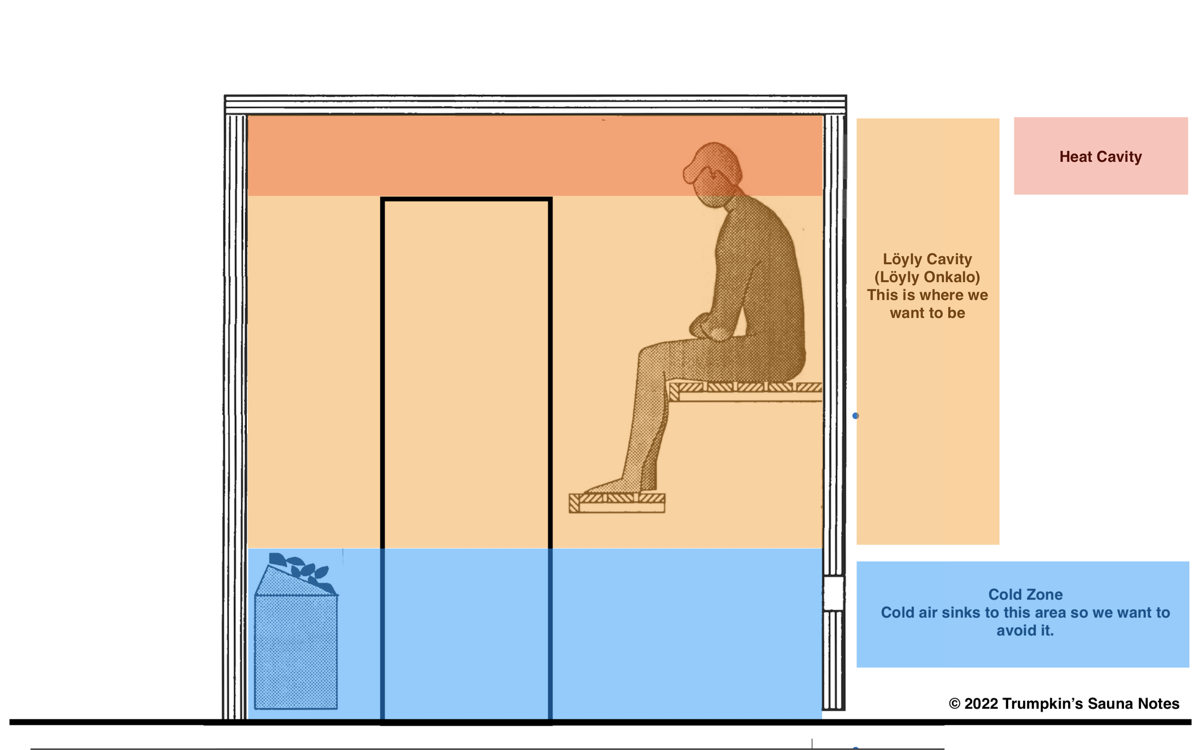
A Lower Cold Zone – In some larger saunas, those larger than about 300 x 300 x 300cm (10x10x10’) a powerful enough convective loop appears to be able to push down in to the cold zone a bit, at least with good temperatures and possibly with steam also.
A Larger Heater Does NOT Help – A larger or more powerful heater cannot overcome stratification and often makes it worse. When you add heat to a room the hot air rises to the ceiling. No matter how much you add though the floor will stay about the same temp. We saw this in our line chart above – as the sauna heats up, the higher you are the more the temps increase and the lower you are the less they increase. Higher ceiling temps plus the same floor temp equals greater stratification.
A larger heater can heat the room faster or maybe achieve higher temps but it cannot eliminate stratification nor cold feet from too low of benches. Proper heat in a sauna is more about finesse than braun.
Something American’s often mistake for reducing stratification is direct radiant heat on their feet and legs from the heater. This however is very different from the proper convective heat that sauna is about.
This knowledge of the heat zones and what happens in a sauna will help us to determine the best dimensions, bench and ceiling heights. In general we’ll want a somewhat larger room and higher ceiling for several reasons;
- Getting the foot bench and so all of our body up in the Löyly Cavity.
- Getting us above the Cold Zone (sometimes more important than ‘above the stones’).
- Having sufficient overall volume of space per bather.
- Getting the sitting and foot benches high enough for heat to kill mold and bacteria.
- Creating a large Heat Cavity for greater comfort and less wasted energy.
- Reducing direct radiant heat from the heater and stones.
- Reduce energy loss/costs.
For those interested in a brief deeper dive…
Radiant heat is wonderful. Feeling the sun on a cool day or a campfire at night. Dinner outside on a cool night with radiant heaters overhead makes for a very enjoyable evening.
Everything around us emits radiant heat and anything that’s colder than any received radiant heat will be heated by it.
When we are sitting in a sauna, everything in there, including the walls and the person sitting next to us, is emitting radiant heat. Any radiant heat that reaches us and is warmer than our skin will be absorbed and potentially felt.
Radiant heat is however very uneven. It is very directional, declines as it travels and its strength in any one spot varies with its source. One of the great things about a good sauna and what makes it so comfortable and enjoyable is that we are heated very evenly from head to toes and front to back. Radiant does not provide this evenness.
The undesirability of radiant heat has been known for decades. In his 1977 book ‘Sauna’ for example, Alpo Reinikainen said:
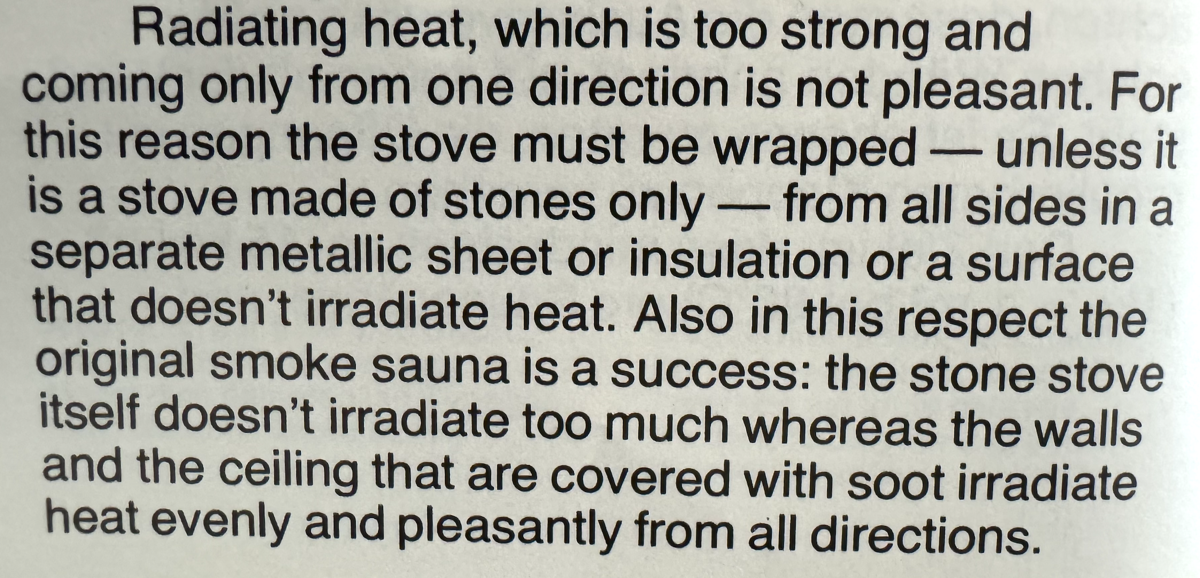
Front vs Back – A bit of radiant on our back in a sauna can feel quite good. This radiant from the back wall is quite mild and very even however. Radiant on our front and particularly on our face does not usually feel so good as our face and front is much more sensitive to heat.
Radiant is Absolutely Directional – and so is felt unevenly on our body. You feel it only from where it is emanating and it can somewhat easily be blocked. Radiant is like light from a flashlight shining on someone in a dark room – where there’s light is radiant heat. And where there are shadows is not. We’ll be warm or hot where there is light but cooler or cold where there are shadows. In a sauna we want to be heated very evenly, caressed, radiant doesn’t do that.
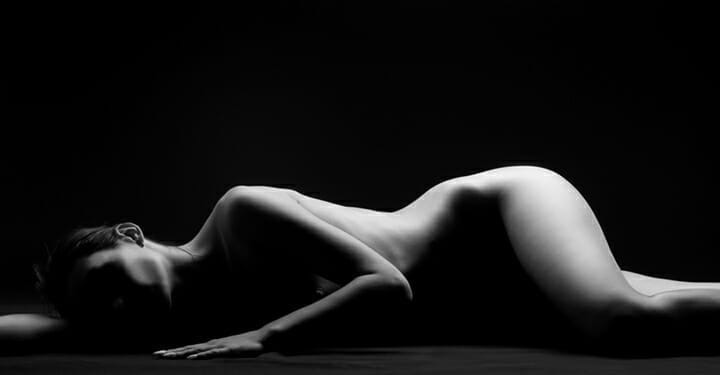
This is why an IR booth (radiant heat) has panels on all walls but a sauna (convective heat) needs only one heater.
People in IR Booths, Sweat Cabins and Banyas often move around to try to even out the radiant heat they feel as best they can; their arm blocks it from their side so they move their arm, there’s too much on their feet so they turn away from the source a bit.
Radiant heat declines – as it spreads out so the further you are from the source the less you will be affected by it. Both of your arms may feel radiant heat from a heater but the arm closest to the heater will feel much more than the arm further away. This decline follows the inverse square law so for example, doubling the distance from the source can reduce radiant by ≈4x.
Point Source vs Mass Source – Point-source is radiant from a smaller single point such as a sauna heater. This is the most harsh and uncomfortable. Mass-source is when the source is very large relative to us or there are many sources from different directions. The walls of a sauna are mass-source as are those of a laconium, caldarium or tepidarium. An IR booth with panels on all sides is somewhat mass source though not as even as those former. We feel this more evenly on all parts of our body.
A large 8’ high x 5’ wide banya oven is kind of mass-source. It’s not as even as all of the walls but much better than a small sauna stove. When using small banya stoves they will often place stone slabs on a large portion of the wall behind the stove to reflect the radiant from the stove and kind of emulate the more mass source heat of a larger banya oven and avoid the more uneven and harsh point-source heat of the smaller stove.
Of thermal experiences the most even and comfortable radiant heat is a Laconium, Caldarium or Tepidarium. The radiant in these is very even because it is from all directions and thanks to the stone is very even from all directions.
Key radiant sources to consider in a sauna:
Heater – This can, depending on the design, emit a lot of radiant heat, is relatively point-source and so very directional on bathers bodies and can vary considerably from one place on our body to another. There are two related issues with radiant heat from the heater; 1) it’s directly uncomfortable and perhaps more important 2) the more radiant the heater emits the less convective heat it produces.
We’ll feel radiant on our side facing the heater and not so much on any parts of our body facing away. This unevenness is uncomfortable and undesirable so we want to minimize radiant heat from the heater as much as we can with good heater design and placement far enough away from bathers (4x-8x the distance to combustibles).
Heat transfer is a zero sum game. If you increase one, you decrease others. If there’s an increase in radiant, there’s a decrease in convective (and conductive), and it’s this convective heat and the convective loop that provides the more even and comfortable heat and steam that make saunas so unique, enjoyable and popular.
Most good sauna heaters, such as those from Narvi, Iki or Helo produce very little radiant.
Wood Walls, Ceiling & Benches – This radiant heat is usually quite mild, is mass-source rather than point-source, and so is fairly even on our bodies which is not only not as uncomfortable as point-source but can be rather pleasant in some cases. This is for our purposes also somewhat inconsequential. We cannot really control it very well anyway other than using materials such as soft wood, avoiding materials that might create an uncomfortable amount of radiant and avoid building too small of a sauna (particularly having the heater wall too close to the bench wall).
Since this radiant is so minimal, mass source and felt more evenly on our bodies, a minimal amount of this from the wall on our backs can be desirable, especially on a cold day with lower sauna temperatures. One stated benefit to thicker log or timber construction is that the greater thermal mass of the walls produces more of this lighter and more even radiant heat on bathers backs.
Lassi says that people in Finland will sometimes go back in to the sauna at the end of the day after it’s cooled a bit for ‘after löyly’, sitting with their back against the wall to enjoy this milder radiant.
So this radiant is not itself at all bad.
Stone, Steel or Similar. A steel or stone wall can emit a lot more radiant than a wood wall and sometimes an uncomfortable amount. In most cases these are not a big problem but they can be so some caution is warranted. On the flip side, in a Banya with a smaller modern banya stove they will often do slab stone walls behind the stove. These reflect radiant heat from the stove towards bathers and help to even out and lessen the harsher point-source radiant from the stove alone.
Sauna walls need radiant heat from the stove so that they can be heated ? – Not really. Firstly, If this were true then the best sauna heaters in Finland – would be the worst as they emit so little radiant heat they wouldn’t be able to heat the walls. Sauna heater manufacturers would be trying to increase radiant rather than reduce it.
Second, we know empirically that the walls in a sauna are heated almost exclusively by convective heat. We can see this with IR images of saunas that indicate the heat from the walls track the stratification of the ambient (convective heat) temperatures – hotter near the ceiling, cooler near the floor. EVERY good sauna I’ve done thermal imaging of has shown the same stratified result (this is also a good way to get a rough idea of ambient temps in a sauna).
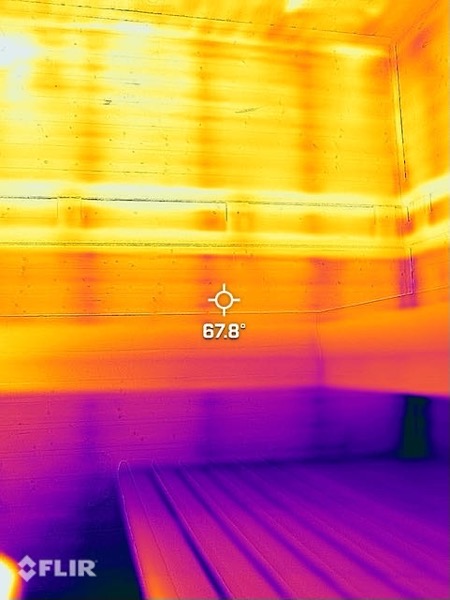
If radiant was a practical factor in heating the walls then they would be quite even from floor to ceiling. Or actually the walls would likely be hotter at heater level that is much closer to the source – radiant heat from the heater, and cooler near the ceiling that is further away and receives much less radiant heat. If you take the ceiling off of this sauna so that the convective heat can escape then you’d begin to see the walls heated more by radiant and they would be hotter at heater level and cooler near the tops of the walls.
Radiant and Conductive heat travel equally in all directions, Convective heat stratifies (e.g., hot air rises) in fluids such as air or water as we see in the image above.
Third, enough radiant to heat the walls could cause severe burns on bathers who are much closer to the source. In the image above there are two small places where radiant is a significant factor in heating a surface. First is the front edge of the sitting (upper) bench on the left of the image where it is near and above the heater. The second is the front edge of the foot bench at the bottom of the image where the foot bench is only a few inches from the heater. With the latter you can also see on the foot bench how quickly radiant heat declines as it spreads out. If you place your hand near either of these it will begin to burn almost immediately from radiant heat.
The really hot spot in the lower left corner is the heater guard that is being heated by radiant.
Now think of someone sitting on the bench in the photo. The wall is ≈68°c. If that 68°c had been from 68°c radiant heat from the heater then someone sitting there would be experiencing much more. If their knees were half the distance to the heater (which is the case here) then they would be experiencing between about 150°c and 270°c. That wouldn’t be pretty.
How much radiant do we experience? This will vary from sauna to sauna. If our sauna here is 94°c (ambient temp @ 1m above the sitting bench) then the walls at that height are a slightly cooler 91°c. The walls are slightly cooler because some of the heat is traveling through the wall (conduction) towards the cooler exterior. At the foot bench the ambient air temp is about 66°c, the walls about 61°c and the bench about 64°c. After 8 minutes in the sauna my skin, according to our FLIR, is about 57°c (134.6°f) on average – slightly warmer on my face and slightly cooler at my feet.
So the highest heat I experience on my 57°c skin at chest level is ambient air of 79°c. Next then is radiant heat of perhaps 71°c on my back and about 0°c elsewhere (74°c @ the wall declines to 71°c at my back, 74°c at the side walls declines to well below my skin temperature by the time it reaches my sides or front so I will experience no effect from it).
Contrary to a sauna that should have no noticeable radiant heat from the heater, a Russian Banya is a very different experience and has a mix of radiant and convective (and conductive via steam). While sauna heaters are designed to produce as little radiant as possible, the oven in a Banya is designed to produce both. This is one reason they are so large, because radiant is more comfortable when it comes from a larger source and so is felt more evenly on our body. Interestingly, Finns, Germans and others who are use to saunas with no radiant will notice the radiant of a banya while people who are accustomed to having some radiant will rarely notice the lack of it.
If you read much about sauna or talk to people in Finland or Germany about them you’ll hear the term Cold Feet or Cold Toes. This is how people in Finland refer to a sauna with too much heat and steam stratification – too great a temperature and humidity difference from head to toes. Typically more than about a 20% head to toes (head to foot bench) temp difference is cold feet. Sometimes, even with very little stratification, if their feet on the foot bench aren’t up in the steam they might complain about Cold Toes as well.
Cold is a relative term. In a sauna the ‘cold zone’ is actually quite warm, perhaps 50°c (122°f) on average. But compared to higher up where our head is in perhaps 90-105°c (194-230°f) temps it can feel, relatively, ‘cold’. It’s similar with ‘cold feet’ or ‘chilly backs’. Temps at the foot bench might be 50°c (122°f) which in a normal room would be hot but if our head is in 94°c (200°f) air then our feet can feel ‘cold’ at 50°c. But far more critical is that our body perceives itself to no longer be in homeostasis and tries to correct that rather than how we want it to react.
We won’t much notice a head to toe difference of less than about 15-20°c (27-36°f) but most people, those who are accustomed to a proper sauna, will begin to notice differences greater than that.
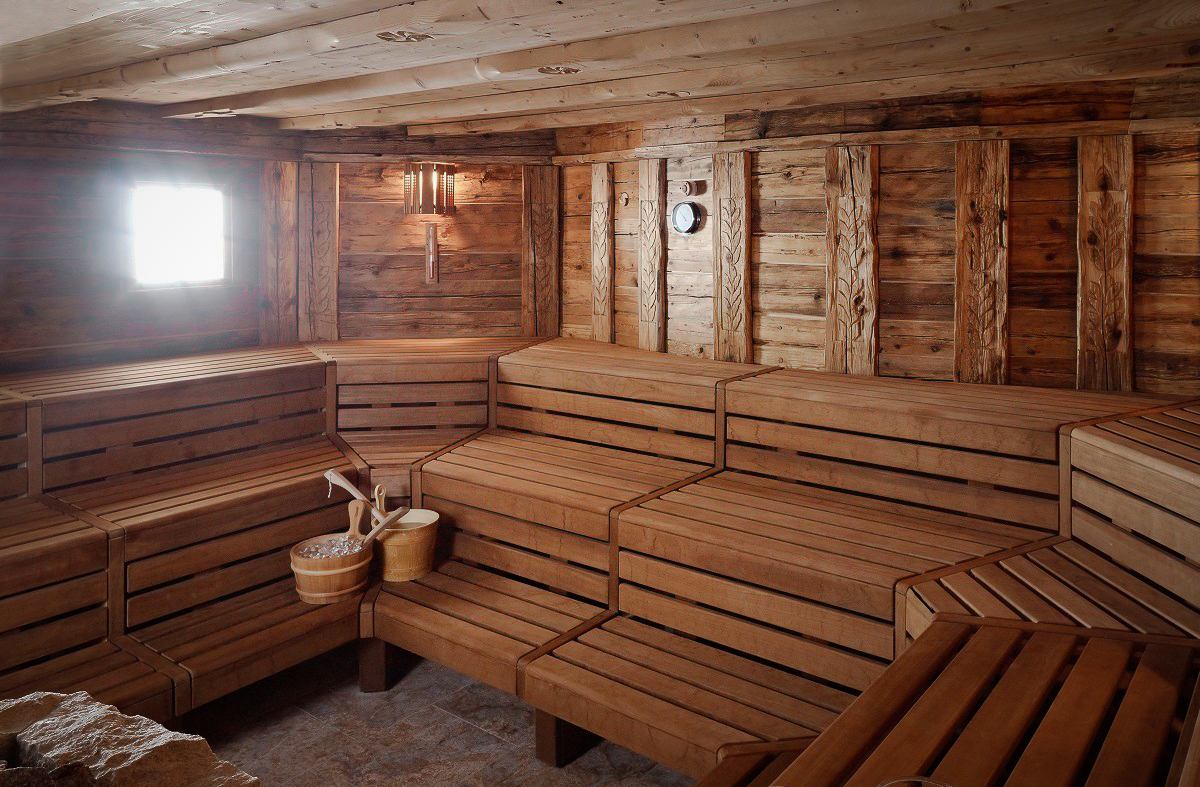 One of the saunas at the Grand Hotel Kronenhof in St Moritz SE. Even the Swiss know how to build them right 🙂 The three bench levels get bathers on the sitting bench above the cold zone and up in the löyly cavity so they’ll have a wonderful sauna experience with even temps and steam and no cold feet after a day of spectacular nordic skiing.
One of the saunas at the Grand Hotel Kronenhof in St Moritz SE. Even the Swiss know how to build them right 🙂 The three bench levels get bathers on the sitting bench above the cold zone and up in the löyly cavity so they’ll have a wonderful sauna experience with even temps and steam and no cold feet after a day of spectacular nordic skiing.
Many people in North America say that they don’t have ‘cold feet’ in their sauna. This primarily because they’ve never experienced a proper Finnish sauna. After raising their benches and fixing their ventilation, they have a revelation of what they’d been missing and how much better a sauna can be when the head to toe differential is decreased from bad to good.
Cold feet can also make our head, and so us, seem much hotter than it really is. In a sauna with a lot of stratification resulting in cold feet we might think that 140°f at our head is really hot. But then in the same sauna but with higher benches and ceiling and so no cold feet we find that 180-220°f is much more comfortable and enjoyable than our old low bench sauna at 140°f. A core element of this is that our bodies want to always be in homeostasis – a stable equilibrium. When our head is much hotter than our toes our body prioritizes this and reacts to this heat differential rather than just heat. That is not what we want in a sauna.
One doctor also mentioned to me that such high differentials between head and toes may not be healthy for us though I’ve not been able to find any research to substantiate that.
Cold Feet / Hot Head – In a sauna with too much stratification, usually from too low of benches and ceiling, our body will perceive temps as hotter than they are. Our body wants to be in homeostasis – equilibrium – and if our head is more than about 15°c warmer than our toes it may react to this temperature difference rather than to heat in general. That’s not what we want in a sauna.
If you feel like you need to wear a sauna hat then that is likely because of too much stratification – a hot head and colder feet. This is perhaps why you don’t often see people wearing sauna hats in Finland where saunas aim to have very even heat.

Bench and Ceiling Heights Method 5: A Bit Of Physics – The advent of open sided mesh heaters generally and open sided mesh pillars in particular has changed things a slight bit. ‘Feet Above The Stones’ still applies and is still the best/simplest rule to follow but with mesh heaters we have more options if we need them.
First, the higher the space, the higher you are in the space, the greater the cold zone below you and the greater the heat cavity above the door – the less of a head to toe difference you’ll experience, the less heat you’ll loose when the door opens, the more steam you’ll experience, the more enjoyable your sauna will be. Higher is better. This is the case regardless of heat source or style of heater.
(There are points of diminishing returns though. Getting the foot bench above the stones and above the cold zone makes the greatest difference and should always be done unless really impossible. From here (usually about a 255cm or 100” ceiling) to about a 400cm (13’) ceiling provides benefit with each cm (inch). Above 400cm the benefits become more marginal and largely unnoticeable.)
Let’s look at why.
No matter how high the ceiling is, the temps near the top and bottom will be about the same given other conditions (fresh supply air, heater, changing room, outside temp, etc.). If the temps are 100°c top and 30°c bottom in a 7’ high sauna then they will be the same in a similar 9’ or 10’ high sauna. Raising a 7′ ceiling by 16” to 8’4” allows bathers to also be 16” higher and have less of a head to toe temperature differential – bathers will be more comfortable and are less likely to have cold feet.
Your feet are 19°f warmer and so you’ve 19°f less head to toe difference in a sauna with an 8’ ceiling than one with a 7’ ceiling. That simple 1’ of extra height makes a huge difference in comfort and enjoyment. The more even head to toe temps are, the less difference there is, the more comfortable and enjoyable a sauna is.
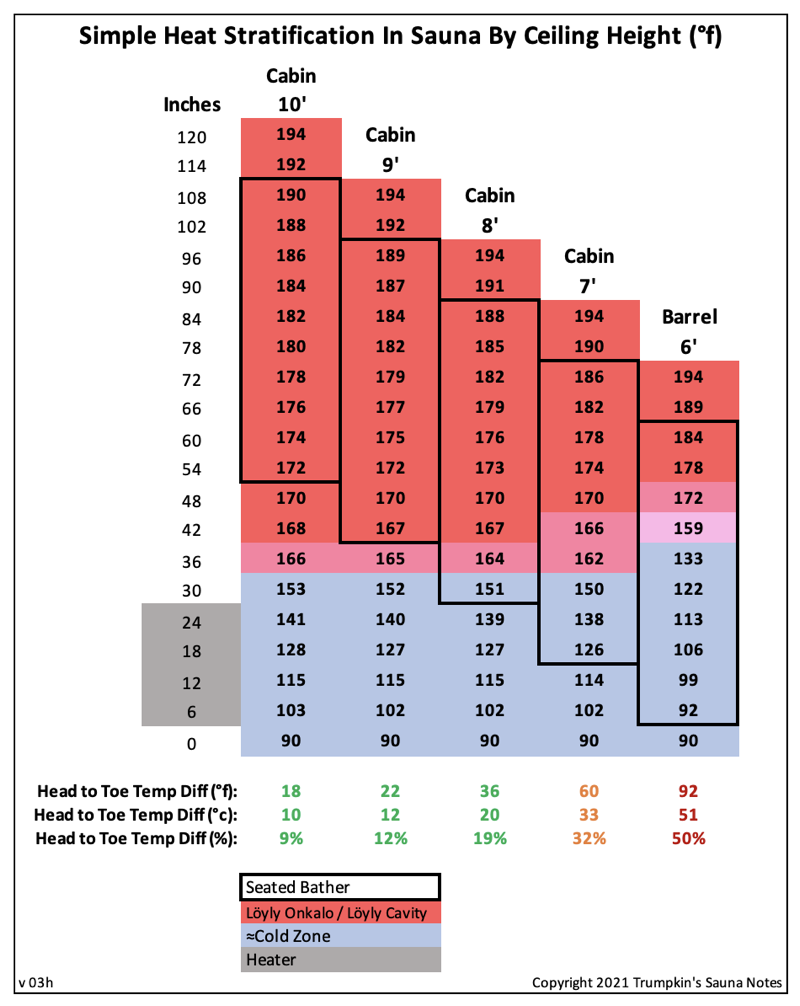
(Heater cooling with fresh air supply below the heater that pulls colder air upwards will make stratification and cold feet worse. Downdraft ventilation with fresh air supply above the heater and that pulls warmer air down around our feet will lessen stratification a bit resulting in a more pleasant and comfortable experience. Do not count on ventilation or air movement to overcome too low of benches though – Proper ventilation can help but not overcome stratification. On the other hand, updraft ventilation can significantly increase stratification and wipe out the benefits of higher benches.)
Let’s look at that IR image again showing how quickly the air cools as you go lower. How cold do you want your feet? (Also note that where the studs are is much cooler than between the studs. This is due to the studs acting as thermal bridges – sucking heat out. This sauna has 2” of continuous insulation on the exterior and would be much worse without that).

So, our first priority is for the foot bench and so our body and feet to be above the cold zone, so above the approximate bottom third (or more) of the space. A good starting point for foot bench to ceiling is 165cm (66”) which is comfortable for someone sitting and allows room for using a vihta. So taking half of this (1/3 of the overall height) is 83cm (34”). Setting our foot bench at least 83cm (34”) high then is our desired minimum. 10-40cm (4-16”) higher is better yet if space allows or even higher if we desire a larger heat cavity.
The sitting bench is then 16-18” above the foot bench. A ceiling at 44-48” above the sitting bench provides more comfortable room for using a vihta and as Risto Elomaa says “this is important”.
If you want a greater sitting bench to ceiling or foot bench/platform to ceiling then a taller room is your friend. The higher the ceiling the less important these distances are because there is less stratification and you are higher above the cold zone. So if you want a 50-52” sitting bench to ceiling for taller people or you want people to be able to walk upright on the foot bench/platform then just make sure that you keep the foot bench/platform above the cold zone and ideally well above it.
If inside and this is higher than your maximum ceiling height then you can play with things to get the best outcome. Select a heater that can be lower perhaps, tighten up the bench to bench and bench to ceiling heights a little. However, try not to have bench heights below about 15” (38cm) or bench to ceiling less than 42-44” (100-110cm).
Our second priority, in addition to the above, is to also have feet above the stones. If you have an enclosed sided heater this is quite critical for a good sauna. These heaters result in a quite well defined löyly cavity due to the convective loop. Placing the foot bench at least 10cm / 4” above the top of the stones is a good minimum to aim for and we want to avoid going much lower as temperature stratification can get quite significant.
 Stairs up to the foot bench are a common element of saunas in Finland.
Stairs up to the foot bench are a common element of saunas in Finland.
Open sided mesh style heaters result in a somewhat less defined löyly cavity from a temperature stratification standpoint and so ‘Feet Above The Stones’ is somewhat less important. But there’s a good and bad to this. Good because it’s not quite as critical to be above the top of the stones. Bad because there can be a bit more stratification in the löyly cavity than with enclosed sided heaters. So the first thing to understand with mesh heaters is that to get a sauna experience equivalent to an enclosed sided heater you actually need a higher ceiling and benches (the lessor stratification of the higher ceiling helps to make up for the greater stratification of the less well defined löyly cavity).
It’s critical to note also that even with open sided heaters steam may not descend below some point above, perhaps 8” above, the top of the stones. So while you may have acceptably even temperatures, you may not get steam down to your toes.
Feet above the stones also increases heat felt evenly around your body from löyly and decreases direct radiant uneven heat from the heater. The former is more comfortable and less harsh than the latter. This is particularly important for bathers closer to the heater.
You still don’t want to be too far below the top of the stones or anymore below than your ceiling height will allow. In other words, higher benches and ceiling are still better.
IR Cabins and Sweat Cabins
It’s important here also to distinguish this thing that Finn’s and German’s call a Sauna from other forms of induced sweating, particularly two that are popular in North America and that often use (or misappropriate) the term sauna:
- IR or lnfraRed Cabins – Bathers are heated primarily by Radiant / IR heat from electric IR panels on the walls.
- Sweat Cabin – Bathers are heated by Radiant / IR heat from a heavy steel stove such as a Kuuma, Nippa or similar. Bathers may also experience some Convective heat though these stoves seem to produce no or only a very weak Convective Loop. These are kind of an amalgam of an IR Cabin, Native American Sweat Lodge and Russian Banya.
These are different experiences from going to a sauna. Neither is, I think, what folks in Finland, or Germany or others, consider a sauna and calling them a sauna doesn’t make them magically become a sauna.
In most forms of sweat bathing radiant is indeed a significant component. In Banya’s and Sweat Cabins from the oven or stove, in Sweat Lodges from the stones, in IR Booths from the IR panels and in Tepidariums/Caldariums/Laconiums from all wall, floor and lounger surfaces.
The most unique and special element of a sauna, what distinguishes Sauna from all other forms of sweat bathing and what makes sauna so popular, is that in a sauna bathers are heated primarily by convective heat via a convective loop and radiant from the heater is intentionally minimized.
In a sauna any noticeable radiant or IR heat from a source “is undesirable” according to Risto Elomaa, president of the International Sauna Association. Eero Kilpi, president of the North American Sauna Society, says about radiant heat “if you can point to a source, then it is undesirable”. In ‘Secrets of Finnish Sauna Design’ Lassi says “Spacious saunas are recommended. Many heater types emit high amounts of radiant heat, which creates an unpleasant feeling in the sauna if you are seated too close to the heater.”
From H.J. Viherjuuri in 1952 (thanks to Risto Rice for pointing this out):
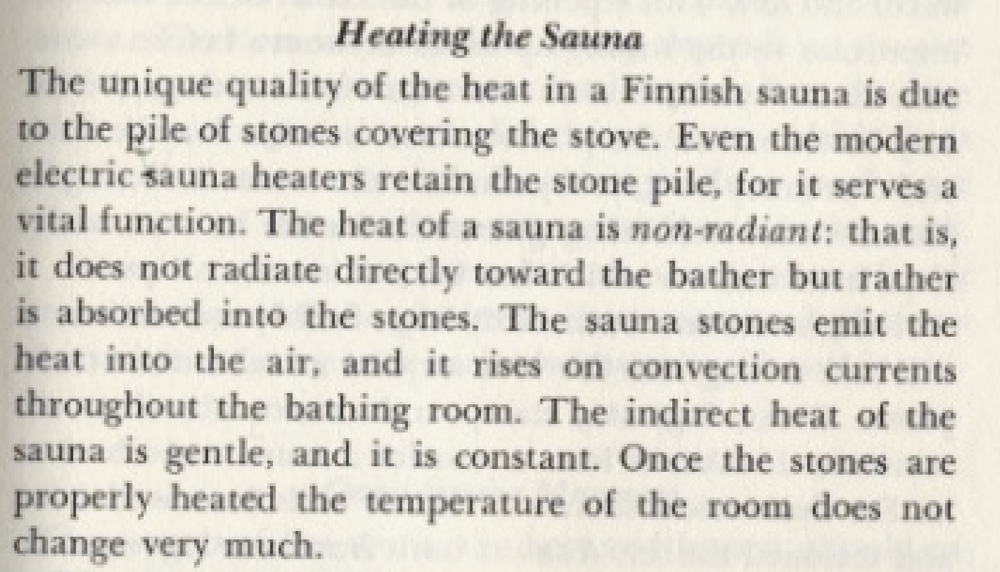
A sauna is indeed an ‘air bath’ of convective heat.
In his 1977 book ‘Sauna’ Alpo Reinikainen said “Radiating heat, which is too strong and coming from only one direction (referring to the heater), is not pleasant”
In the broader world:
- For a Sauna the focus is on reducing direct radiant from the heater as much as possible. Heater manufacturers go to significant lengths in design and manufacture to produce as little radiant from their heaters as practicable. Sauna designers and builders try to place the heater far enough away that bathers don’t feel any radiant from it or they will block radiant with a short wall. For most builders in Finland and nearby it seems almost a non-issue though because the heaters they use don’t produce much radiant and the sauna rooms are by default large enough that the heater will nearly always be far enough away that radiant isn’t an issue.
- In Banyas on the other hand, radiant is quite intentional. An equal mix of radiant and convective (and conduction via steam) is desirable and expected. A banya oven or stove is designed to produce radiant but also to do so from a large surface (mass-source) so that it is more even on bathers. In the case of a smaller modern banya stove similar in size to a sauna heater, they often place stone slabs on the walls, floor to ceiling, behind the stove to mimic a larger traditional banya oven by reflecting radiant from a larger source. This reduces how point-source the radiant is so that it is somewhat more mass-source and comfortable.
- Then Sweat Cabins/Lodges seem to fall somewhere between banyas and IR booths. A banya has some noticeable radiant but also a good convective loop. A sweat cabin is more radiant and less convective than a banya with little or no convective loop. The radiant from a heavy steel stove is also more point source so more harsh feeling than from a larger banya oven.
- IR Booths are primarily radiant heat as are Tepidariums, Caldariums and Laconiums.
- Finally we have Steam Baths which are quite unique as well. Similar to Sauna there is no noticeable radiant heat while conduction via steam plays a much more significant role than in any other thermal experience.
So with a Sauna the goal is to have as little radiant from the heater as possible and ideally no noticeable radiant, while these others all have some intentional radiant from the oven, stove, IR panels or walls.
Here we can see where various sweat bathing experiences fall in the broader spectrum. Lower left are saunas, Russian Banya’s are kind of in the middle, then Sweat Cabins/Lodges and finally IR Booths. Tepidariums, Caldariums and Laconiums are similar to IR Booths (though the heat is much more even than an IR Booth).
Down in the lower left corner are two points that are closest to an ideal sauna. The further away from the lower left corner the lessor or worse of a sauna experience we have.
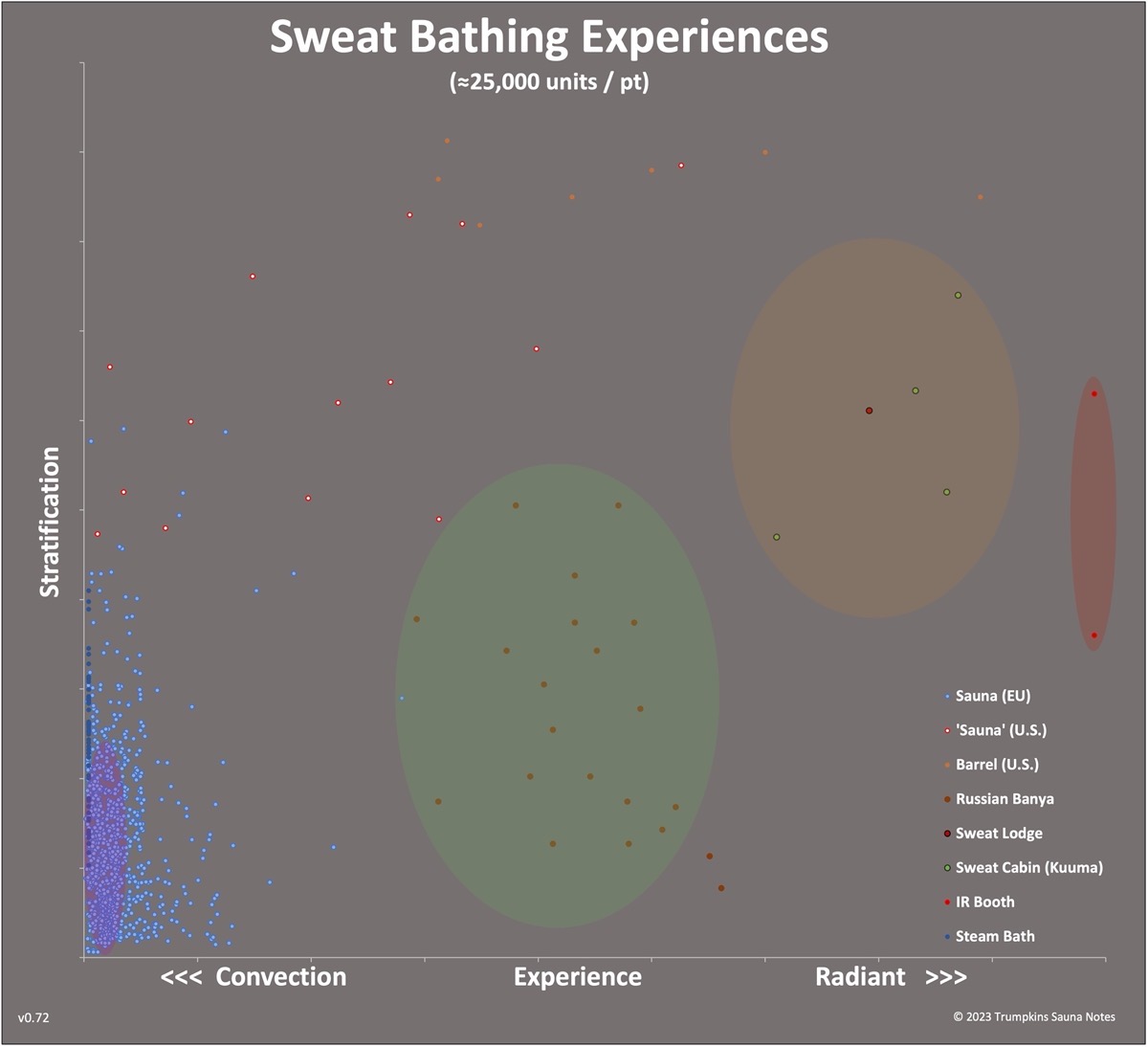
Unlike in a sauna, bench and ceiling height in an IR Cabin or Sweat Cabin doesn’t make as much difference in the experience since IR heat doesn’t stratify as in a sauna where we are heated by even convective heat. So if someone wants a sweat cabin then a 7’ high ceiling is fine, if a sauna then a higher ceiling is much more important. The stratification difference in the IR Booths is that many do not have IR panels lower down which results in a feeling of increased stratification.
Saunas, IR Cabins, Sweat Cabins, Russian Banyas, Sweat Lodges, Laconiums, Steam Baths, Onsens and others are simply different thermal experiences. Some people might prefer one and some another. My personal favorite is a Finnish Sauna but I also very much enjoy Steam Baths, Bio Saunas and Laconiums. On the other hand, Banyas, Sweat Cabins and IR are not my favorites but still fun to do occasionally. Others may have a preference for Banyas rather than Saunas.
Banya’s, Sweat Cabins and even some Barrels are a good alternative to a sauna if a sauna isn’t available. They’re not what people in Finland, Germany and other sauna cultures build as saunas. They are not what they want as saunas. But they are a thermal experience.
To better understand how things go together, here’s a taxonomy of thermal experiences. There is still a lot of detail needed but it’s a start. Note that there are three types of sauna; Finnish, Bio and Hay. Most spa’s throughout Europe will have at least one Finnish and one Bio sauna while Alpine spas often have a Hay sauna in addition to or in place of a Bio sauna.
For more on these different experiences see ‘Sauna and Other Thermal Experiences’ in the menu above where there are more detailed descriptions.

Ideal Sauna Shape?
This is a theoretical / exploratory discussion for those interested.
Earlier we discussed wanting to facilitate the convective loop that forms the löyly cavity but also compress it, and we want to experience as little stratification as possible. In theory then an ideal shape might be;
1) Have the heater wall slope in a bit, perhaps 5-20° but no more. This will narrow the space near the ceiling resulting in less stratification and widen the space at the bottom providing more space for the cold zone and effectively lower it. This will also help to facilitate the convective loop as it will begin directing the rising plume towards the bench wall.
1b) Have the side walls slope in a bit as well for the same potential benefit to stratification.
2) Do a slightly vaulted ceiling (1:3 pitch) with the peak cheated towards the bench wall.
3) Slightly trapezoidal room that’s wider on the bench wall. So if you have an 8’ wide bench wall then perhaps a 7’ or 6’ wide heater wall.
Sloping the walls in slightly will also reduce noise in the sauna as it eliminates the standing waves that are created from parallel surfaces (this is also why recording studios and concert halls have a lot of odd angles).
Thermometers and Other Measurement Devices
Moved to: Notes on Thermometers and Other Measurements
Resources:
Web Links:
Sauna Ventilation – Finding Good Pure Air
Building A Sauna In 13 Minutes Video – By Andrejs Vasevics in Latvia.
The Upper Bench podcast: Secrets of Sauna Design with Lassi Liikkanen.
Books:
EVERYONE building a sauna should read Lassi Liikkanen’s ‘Secrets of Finnish Sauna Design’. I’ve read over 30 books on sauna and sauna design. This is the best and most accurate I’ve found. I wish it had existed when we built our sauna as it would have saved me a lot of research time, a lot of headaches and two remodels.
https://www.amazon.com/Secrets-Finnish-Sauna-Design/dp/1683150260
Lassi also provides consulting services that can be well worth it for those interested.
Other Worthwhile Books:
- Sauna: The Finnish Bath (H. J. Viherjuuri)
- Building A Traditional Finnish Smoke Sauna (Hiltunen)
- Villas and Saunas Of Finland (Hautajärvi)
- The Sauna Book (Johnson & Miller) – Overall good with some good info on construction details. Some info such as on ventilation is quite dated.
- Finnish Sauna: Design & Construction (Rakennustieto Publishing) – Overall good though somewhat dated information. This book is very interesting from a historical perspective but Liikkanen’s book above is largely considered to have superseded it.
- The Modern Sauna (Konya)
- The Opposite Of Cold (Nordskog & Hautala) – One of the best coffee table books for those in North America.
- Cathedrals Of The Flesh (Brue)
- The Sauna Is (Hillala)
- The Best Part of a Sauna (Peterson, Dupre)
- Sweat (Aaland)
- International Handbook of Finnish Sauna (Konya)
- Sauna Magic (Conover)
- Finnish Sauna (Konya)
- Pretty Good House (Maines, Kolbert, Mottram and Briley)
- A House Needs to Breathe…Or Does It? (Bailes)
- Thermal Delight in Architecture (Heschong)
- The Architecture of Bathing: Body, Landscape, Art (Pearson)
Anyone who builds saunas professionally should read or at least browse in depth: This document, ’Secrets of Finnish Sauna Design’, ‘Sauna: the Finnish Bath’, ‘The Sauna Book’, ‘The Sauna Is’, ‘Finnish Sauna: Design & Construction’, ‘Pretty Good House’ and ‘A House Needs to Breathe…’. The latter two are not specific to sauna but to construction practices. Together these should provide a good foundation on some history, how sauna has developed over the past 50 years, and what current best practices are.
I’ve about twenty other books on sauna not listed because they are simply not worthwhile.
Still To Learn:
We see extremely high particulate matter (1.0, 2.5 and 10.0) when ladling water on to the stones. Part of this and possibly all of it is bits of stone breaking off and disbursing with the steam. I’d guess some of it is also from the calrods which isn’t good.
We’re still trying to figure out a good reliable way to measure CO2 near bathers faces during a sauna session. It’s easy to do at lower temps like 60°c but not so much at 90°c which is above the temp range for most meters. Airflow will be different then too so why I’d like to find a good way to measure it.
